Top 50 Amazon Rainforest Animals (With Pictures and Fun Facts)
What Is the Amazon Rainforest — and Why Is Everyone Talking About Its Animals?
The Amazon Rainforest feels like something out of a different world. It’s massive — stretching across nine countries in South America — and it’s teeming with life. Everywhere you look, something is crawling, flying, jumping, or slithering through the trees. It’s home to more wildlife than almost anywhere else on Earth.
Inside this green jungle, you’ll find millions of species: tiny insects, colorful frogs, playful monkeys, powerful jaguars, and creatures so unique that scientists are still discovering new ones. It’s truly a world within a world.
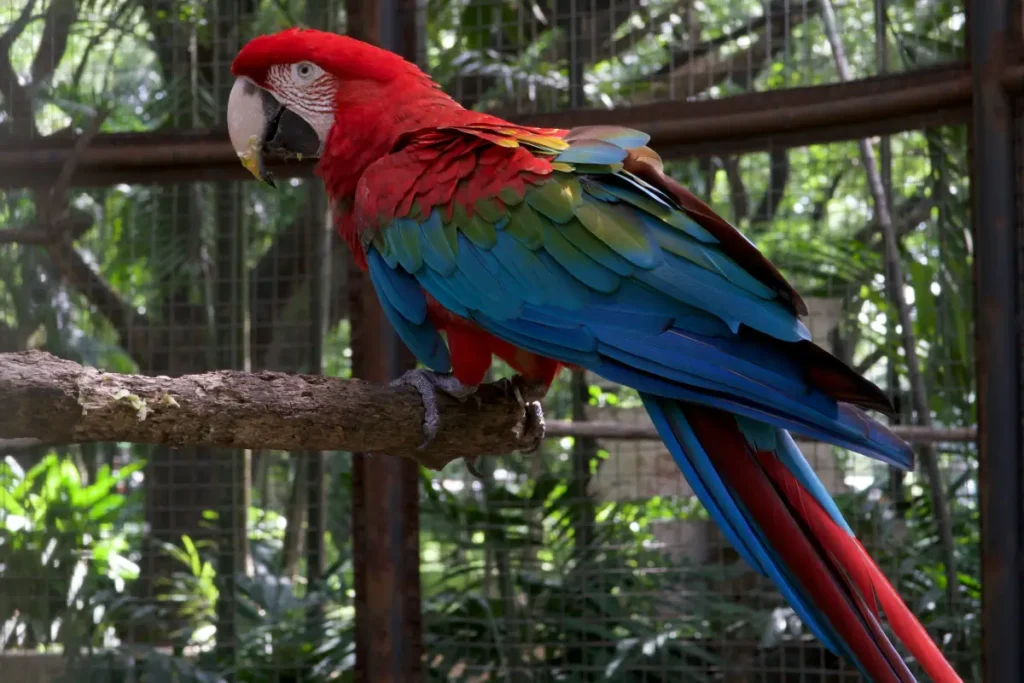
Why Are Amazon Rainforest Animals So Special?
What makes Amazon Rainforest Animals stand out is how incredibly adapted they are to survive in such a wild, humid, and dense environment. Some are masters of camouflage, blending perfectly with the trees and leaves. Others have bright colors to warn predators, and some have wild abilities you’d think only exist in sci-fi movies.
But it’s not just their appearance or skills that make them unique. Many of these animals only exist in the Amazon — nowhere else on the planet. That’s what makes spotting them so exciting and learning about them so important.
What You’ll Find in This Article
Get ready — you’re about to explore 50 amazing Amazon Rainforest Animals. Each one comes with a photo, fun facts, and fascinating details that will blow your mind.
So whether you’re into wildlife, nature, or just curious about what’s out there, this guide will take you deep into the heart of the Amazon. Let’s dive into one of the most incredible places on Earth — and meet some of the wildest creatures you’ll ever see. 🌿🦜🐆
🐾 Amazon Rainforest Animals List
| Animal | Category | Description | Jump to Section |
|---|---|---|---|
| Jaguar | Mammal | Top predator, stealthy and powerful. | See more |
| Harpy Eagle | Bird | Large eagle with strong talons. | See more |
| Poison Dart Frog | Amphibian | Bright colors, toxic skin. | See more |
| Sloth | Mammal | Slow, tree-dwelling and peaceful. | See more |
| Capybara | Mammal | Largest rodent, loves water. | See more |
| Amazon River Dolphin | Mammal | Pink dolphin, highly intelligent. | See more |
| Macaw | Bird | Colorful parrot with loud calls. | See more |
| Green Anaconda | Reptile | One of the heaviest snakes. | See more |
| Bullet Ant | Insect | Painful sting, very aggressive. | See more |
| Toucan | Bird | Large colorful beak, fruit eater. | See more |
| Piranha | Fish | Sharp teeth, carnivorous habits. | See more |
| Tapir | Mammal | Herbivore with short trunk. | See more |
| Howler Monkey | Mammal | Loudest land animal. | See more |
| Glass Frog | Amphibian | Transparent belly skin. | See more |
| Electric Eel | Fish | Can produce electric shocks. | See more |
| Boa Constrictor | Reptile | Kills by constriction. | See more |
| Tarantula | Arachnid | Large hairy spider. | See more |
| Leafcutter Ant | Insect | Famous for cutting leaves. | See more |
| Caiman | Reptile | Small crocodilian species. | See more |
| Ocelot | Mammal | Spotted, nocturnal feline. | See more |
| Black Caiman | Reptile | Largest predator in Amazon. | See more |
| Red-Bellied Piranha | Fish | Sharp teeth, travel in groups. | See more |
| Arapaima | Fish | Giant fish, breathes air. | See more |
| Squirrel Monkey | Mammal | Tiny, energetic primate. | See more |
| Manatee | Mammal | Gentle aquatic grazer. | See more |
| Blue Morpho Butterfly | Insect | Bright blue wings. | See more |
| Amazonian Giant Centipede | Insect | Can eat small vertebrates. | See more |
| Golden Lion Tamarin | Mammal | Tiny monkey with golden fur. | See more |
| Amazon Tree Boa | Reptile | Arboreal and non-venomous. | See more |
| Hoatzin | Bird | Smelly bird with claws. | See more |
| Giant Otter | Mammal | Large, social river predator. | See more |
| Potoo | Bird | Masters of camouflage. | See more |
| Amazonian Royal Flycatcher | Bird | Fan-like colorful crest. | See more |
| Emerald Tree Boa | Reptile | Bright green and tree-dwelling. | See more |
| Pacu | Fish | Looks like piranha, eats plants. | See more |
| Kinkajou | Mammal | Nocturnal, honey-loving climber. | See more |
| Basilisk Lizard | Reptile | Can run on water. | See more |
| Uakari Monkey | Mammal | Red face, short tail. | See more |
| Three-Toed Sloth | Mammal | Slow and algae-covered. | See more |
| Amazonian Umbrellabird | Bird | Has umbrella-like crest. | See more |
| Peacock Bass | Fish | Popular game fish. | See more |
| Green Iguana | Reptile | Herbivorous tree dweller. | See more |
| Spectacled Owl | Bird | Large owl with white face. | See more |
| Amazonian Motmot | Bird | Colorful with racquet tail. | See more |
| Giant Anteater | Mammal | Feeds on ants and termites. | See more |
| Tamarin Monkey | Mammal | Small and playful. | See more |
| Spix’s Macaw | Bird | Rare and brilliant blue. | See more |
| Tiger Cat | Mammal | Small wildcat, elusive. | See more |
| Bushmaster Snake | Reptile | Venomous and dangerous. | See more |
| Anole Lizard | Reptile | Can change color slightly. | See more |
Top 50 Amazon Rainforest Animals
🐒 Mammals of the Amazon Rainforest
Meet the warm-blooded wonders of the jungle. From apex predators to peaceful swimmers, mammals in the Amazon showcase incredible diversity and adaptability.
Jaguar
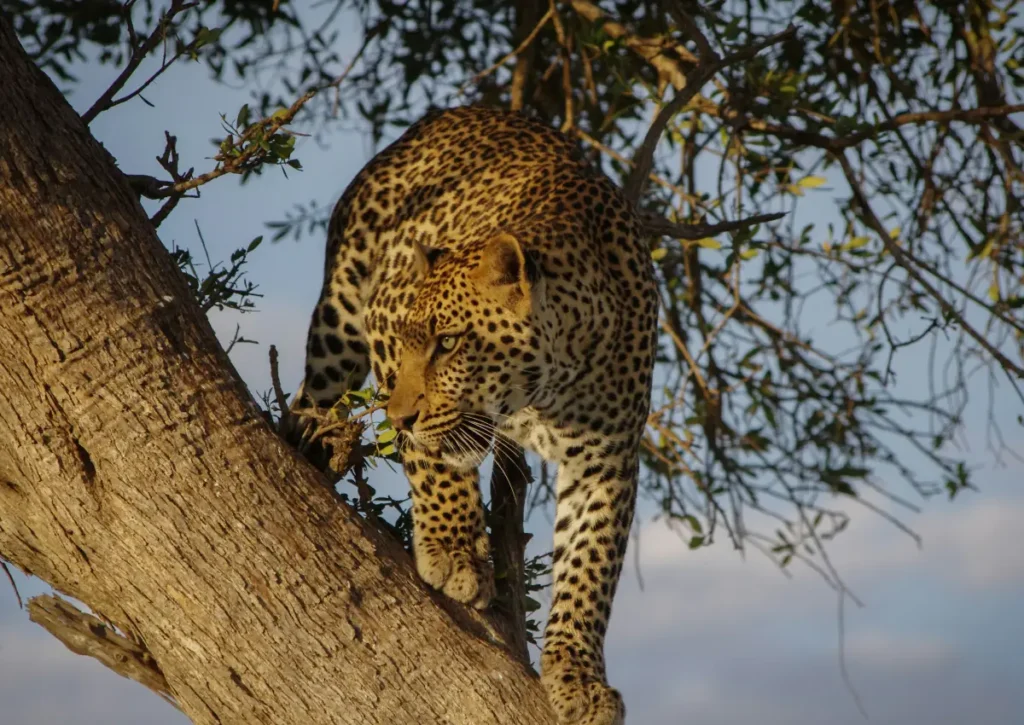
Among all the amazon rainforest animals, the jaguar stands out as the ultimate predator and the largest big cat in the Americas. It lives deep in the rainforest, thriving in thick jungles and swampy areas where it can move like a ghost. Jaguars have a terrifying bite that can crush skulls and crack turtle shells, and their menu is just as intense—capybaras, deer, monkeys, and even caimans. But here’s the wildest part: unlike most big cats, jaguars are obsessed with water. They swim like champs and often dive into rivers to hunt, making them one of the most badass hunters in the entire Amazon.
Sloth
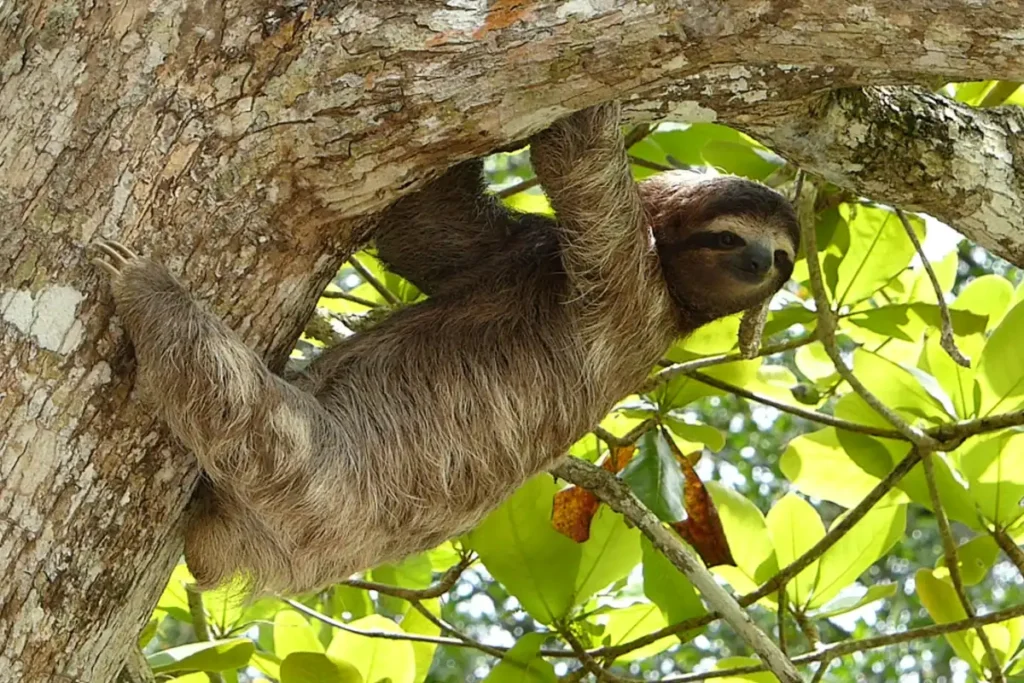
Sloths are easily some of the most fascinating amazon rainforest animals, spending nearly their entire lives hanging upside down high up in the rainforest canopy. They move incredibly slowly—not because they’re lazy, but because their slow metabolism helps them avoid attracting predators. What’s even cooler? Their shaggy fur isn’t just fur—it’s a whole ecosystem. Algae grow on them, giving their coats a greenish tint for camouflage, and tiny moths and insects live right there with them. Yup, sloths literally carry the rainforest on their backs.
Capybara
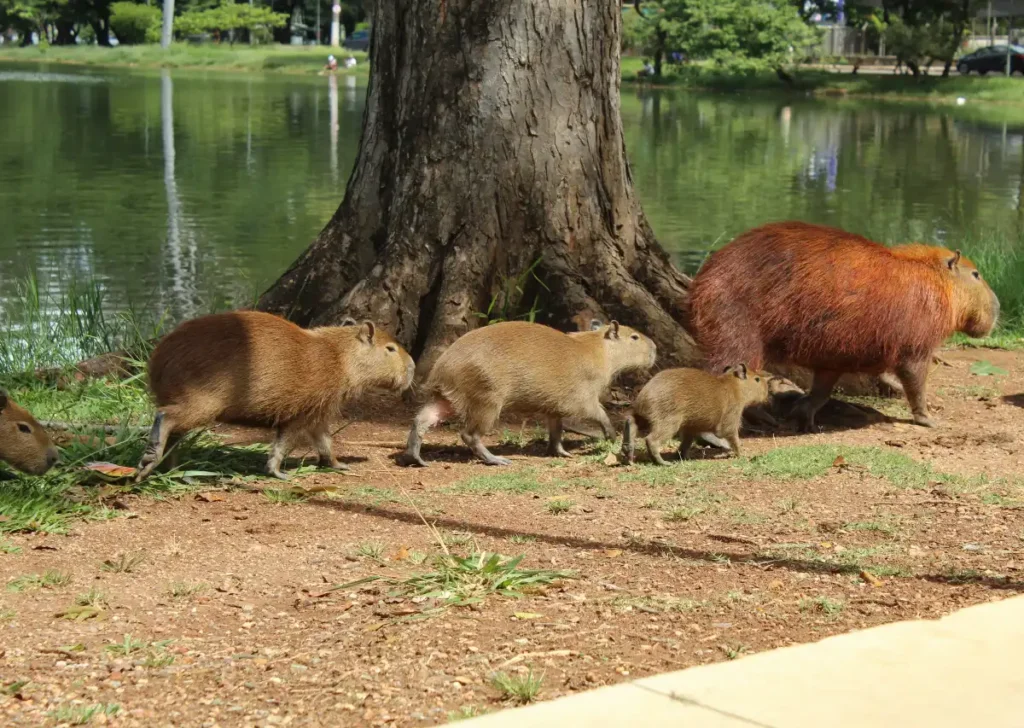
Capybaras are one of the most lovable amazon rainforest animals, known as the world’s largest rodents and total chill experts. These gentle herbivores live in groups near rivers and wetlands, often lounging in the water like it’s a spa day. Their webbed feet turn them into natural swimmers, gliding through the water with ease. They don’t just hang out quietly either—they “talk” to each other using barks, whistles, and even purrs. Honestly, if you ever spot a crew of capybaras by the riverbank, it’s like catching a glimpse of the rainforest’s most relaxed social club.
Amazon River Dolphin

The pink river dolphin, one of the most unique amazon rainforest animals, is often called the “boto” and feels straight out of a fairy tale. Found gliding through the flooded forests and winding rivers of the Amazon, it uses its flexible neck to twist and turn with surprising agility. But what really sets it apart—besides its unusual pink color—is the mystery that surrounds it. According to local legends, this intelligent creature can shape-shift into a human at night, adding a magical layer to its already fascinating nature. It’s not just a dolphin—it’s a living myth swimming through the heart of the rainforest.
Tapir
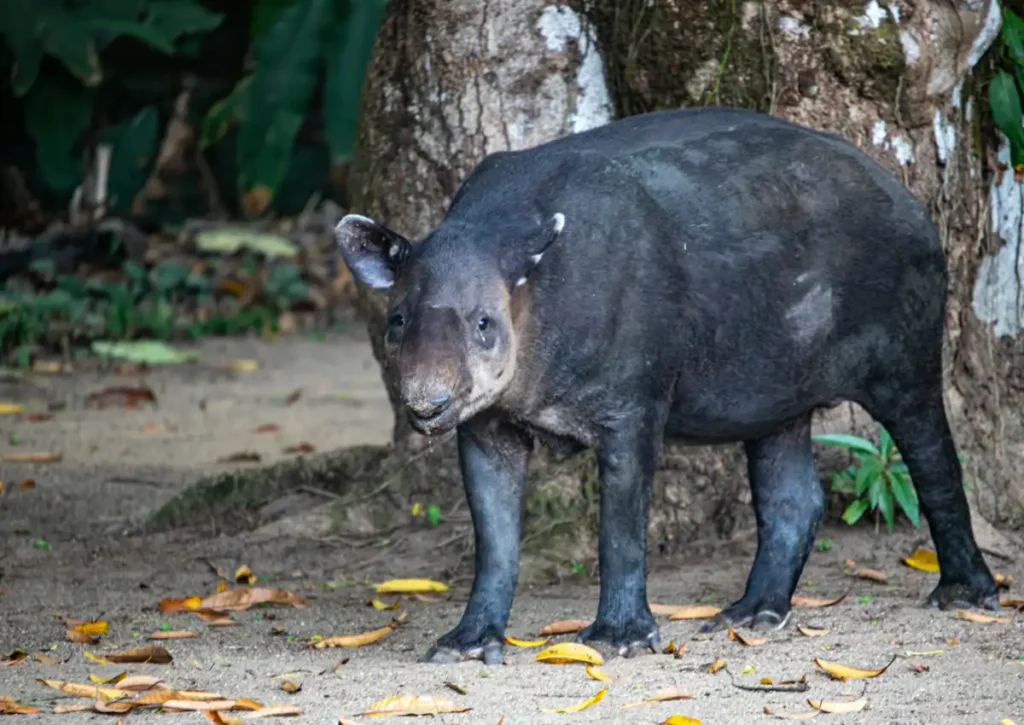
Tapirs are some of the most underrated amazon rainforest animals, looking like a quirky mix between a pig and an anteater, but with their own charm. These shy herbivores use their short, flexible trunks like built-in grabbers to pull in leaves, fruits, and other tasty forest snacks. They might be big, but they’re not fans of attention—they stick close to rivers where they can quietly swim to cool off or slip away from predators. Spotting one in the wild feels like finding a rainforest secret most people don’t even know exists.
Howler Monkey
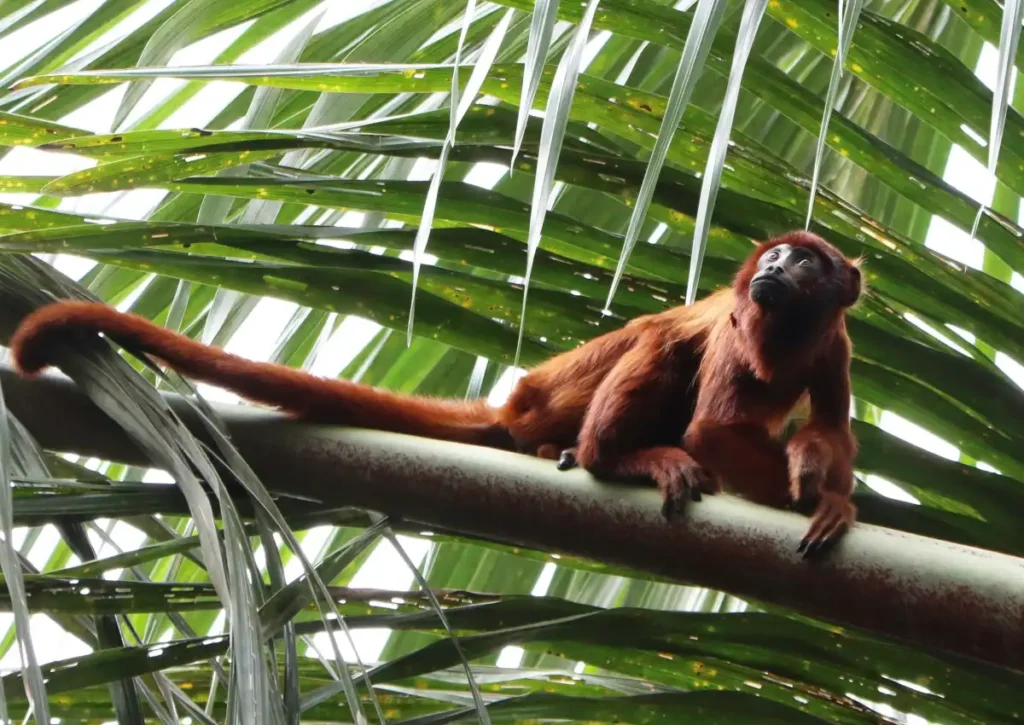
Howler monkeys are some of the loudest and most recognizable amazon rainforest animals, famous for their deep, booming calls that roll through the trees at sunrise and sunset. These highly social primates live high in the canopy, where they use their strong, prehensile tails like a fifth arm to swing, grip, and lounge among the branches. Their diet? Mostly leaves, which they munch on all day like true tree-dwelling vegetarians. If you ever hear the forest “roar” out of nowhere, chances are you’ve just been greeted by a howler monkey choir.
Squirrel Monkey
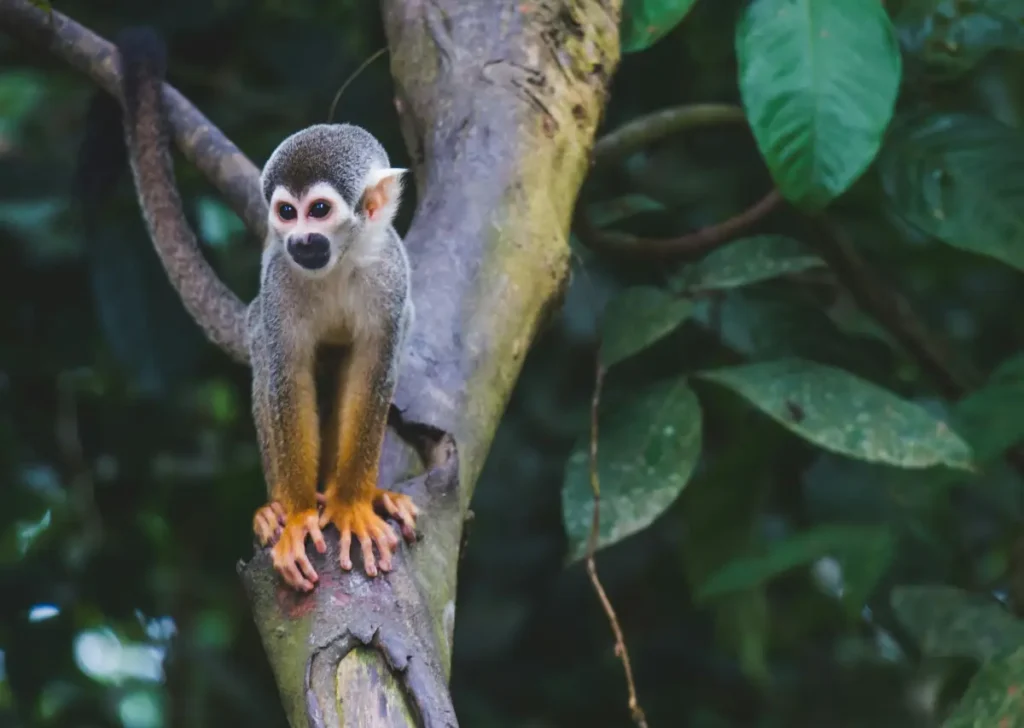
Squirrel monkeys are among the most energetic and playful amazon rainforest animals, zipping through the treetops in big, noisy groups that never seem to sit still. These tiny primates rely on their sharp eyesight and nonstop chatter to stay connected and avoid danger while navigating the dense canopy. Their diet is a colorful mix of fruits, insects, and flowers—basically anything they can grab on the go. Curious by nature and lightning fast, squirrel monkeys turn every inch of the rainforest into their personal playground.
Manatee
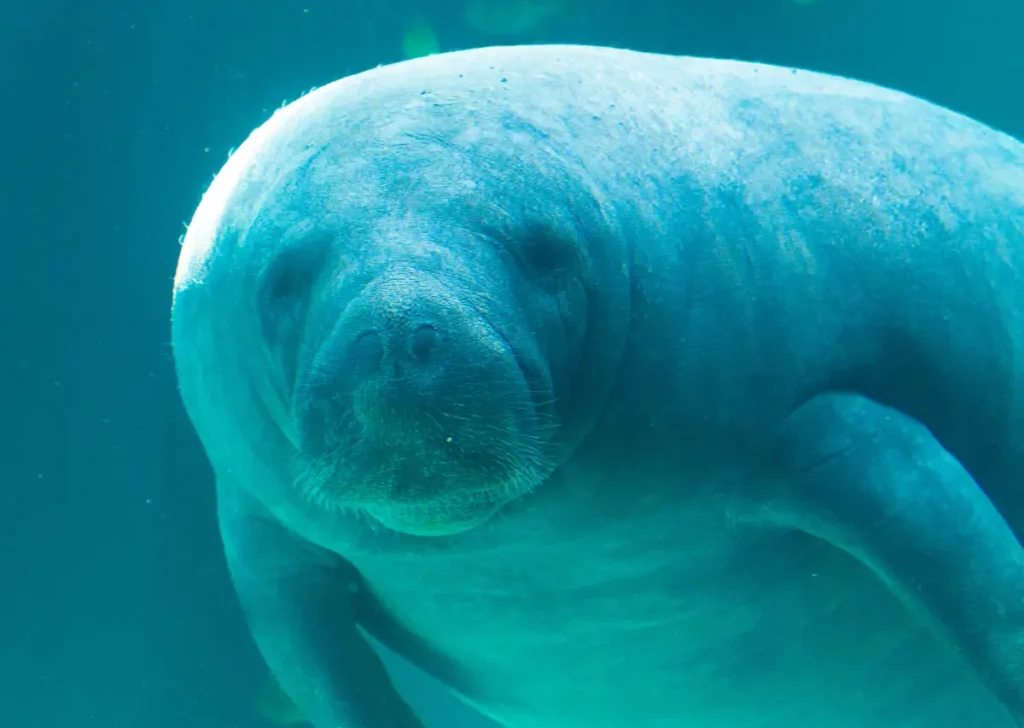
The Amazonian manatee is one of the most peaceful amazon rainforest animals, slowly drifting through calm freshwater rivers as it grazes on aquatic plants. Unlike its relatives, this gentle giant lives exclusively in freshwater and has adapted perfectly to life in the still, murky waters of the Amazon. Sadly, it’s also incredibly vulnerable—boat traffic and habitat loss have put it at serious risk, which is why it’s become a major focus for conservationists. Spotting one in the wild is rare, but unforgettable—like seeing a floating, underwater cow just minding its business.
Golden Lion Tamarin
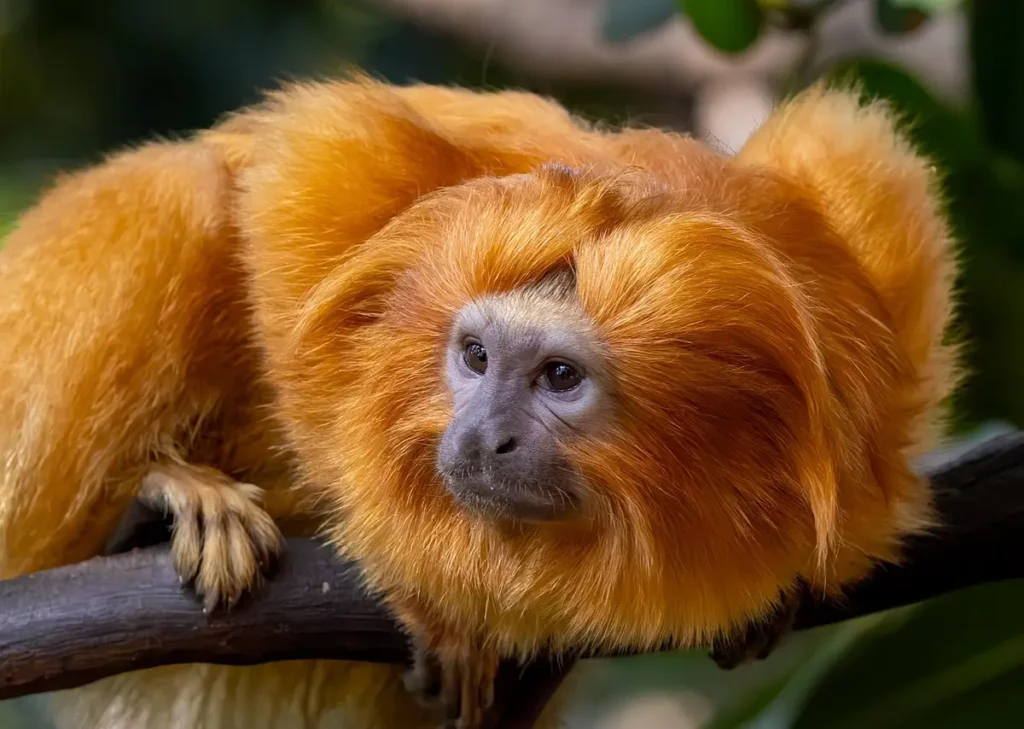
The golden lion tamarin is one of the most striking amazon rainforest animals, a tiny monkey that looks like a living flame with its bright orange fur and wide, expressive eyes. These little primates are incredibly social, sticking close to their family groups as they leap through the trees with endless curiosity. But despite their charm, they’re in serious danger—habitat destruction has pushed them to the brink, and their survival now depends on ongoing conservation efforts. Seeing one is like spotting a piece of treasure moving through the forest.
Giant Otter
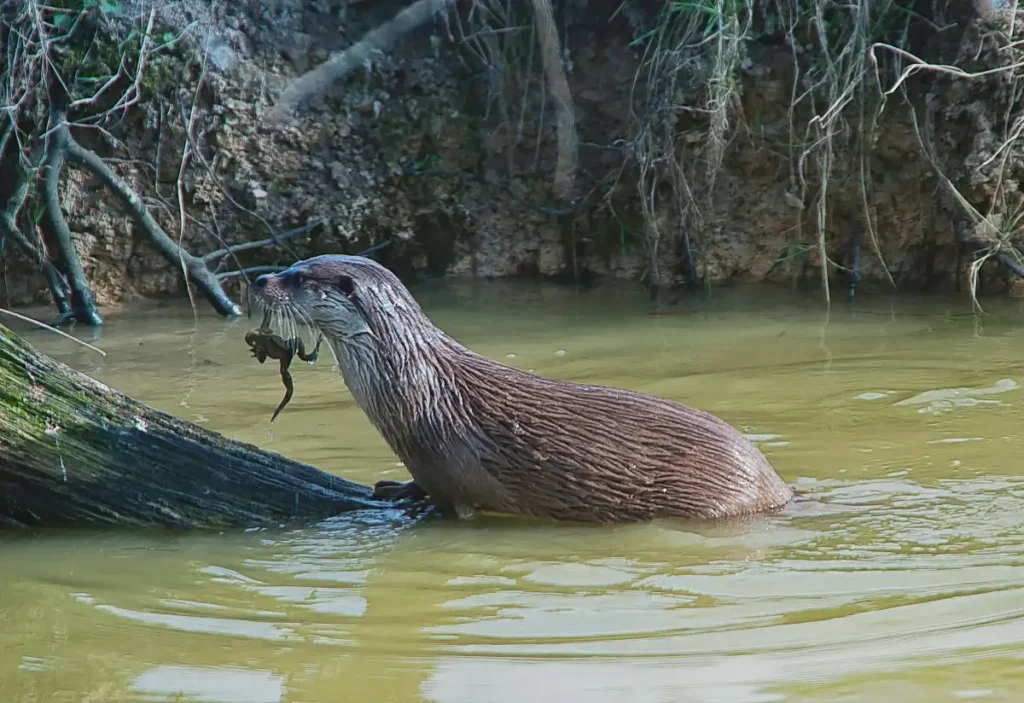
The giant otter is one of the most impressive amazon rainforest animals, known for its speed, sharp mind, and strong family bonds. Living in tight-knit groups, these sleek swimmers rule the rivers and oxbow lakes of the Amazon with powerful jaws and nonstop teamwork. They’re fearless hunters, often going after fish—and yes, even piranhas—without hesitation. Their constant chatter and playful energy make them one of the rainforest’s most fascinating creatures to watch in action.
Ocelot
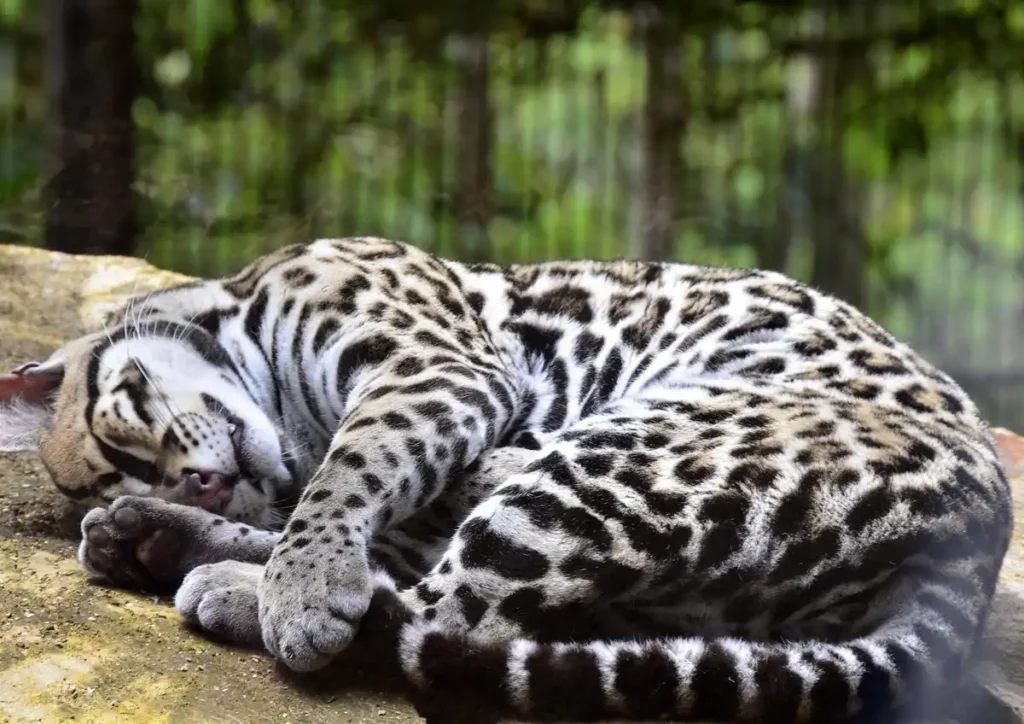
Ocelots are some of the most mysterious amazon rainforest animals, slipping silently through the underbrush under the cover of night. These small, spotted wildcats are expert hunters, using stealth and patience to catch birds, rodents, and other small mammals. Their stunning fur and elusive behavior have made them a favorite among wildlife photographers, though spotting one in the wild is a rare and magical experience. They’re like the rainforest’s secret shadow—quiet, beautiful, and always on the move.
Kinkajou
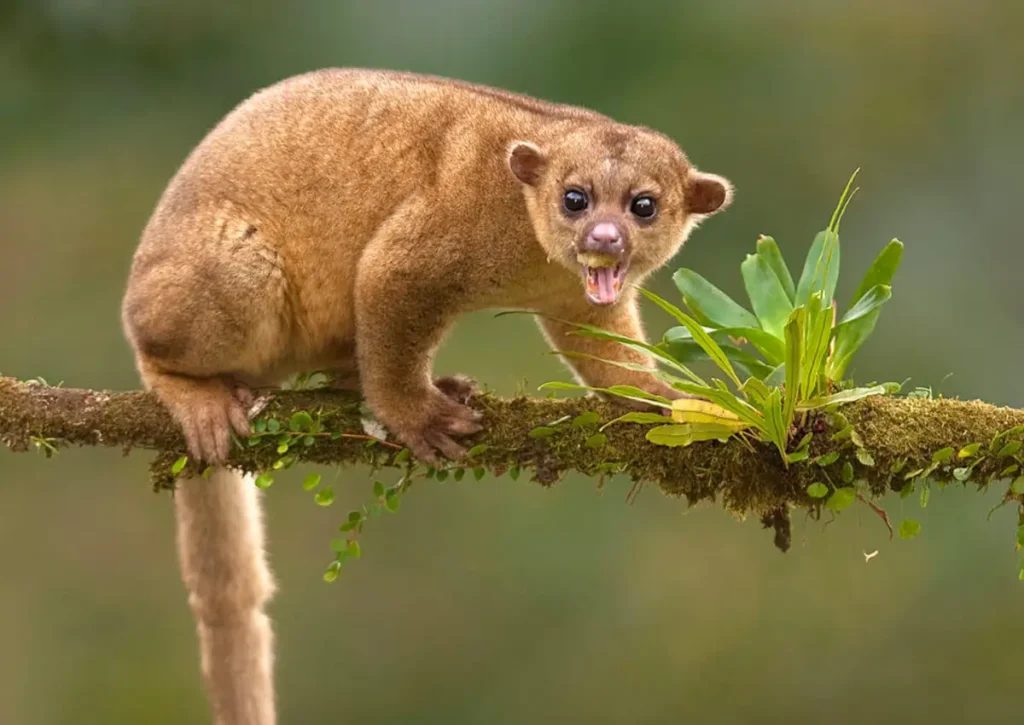
The kinkajou, one of the more unusual amazon rainforest animals, is often nicknamed the “honey bear” for its sweet tooth and furry charm. This nocturnal creature lives high in the treetops, using its long, prehensile tail like a fifth limb to climb and hang with ease. Its diet is a sugary mix of fruit, nectar, and honey, and it has an impressively long tongue that lets it reach deep into flowers and even beehives. With its big eyes and sneaky nighttime habits, the kinkajou feels like a rainforest mix between a monkey, a bear, and a little thief.
Uakari Monkey
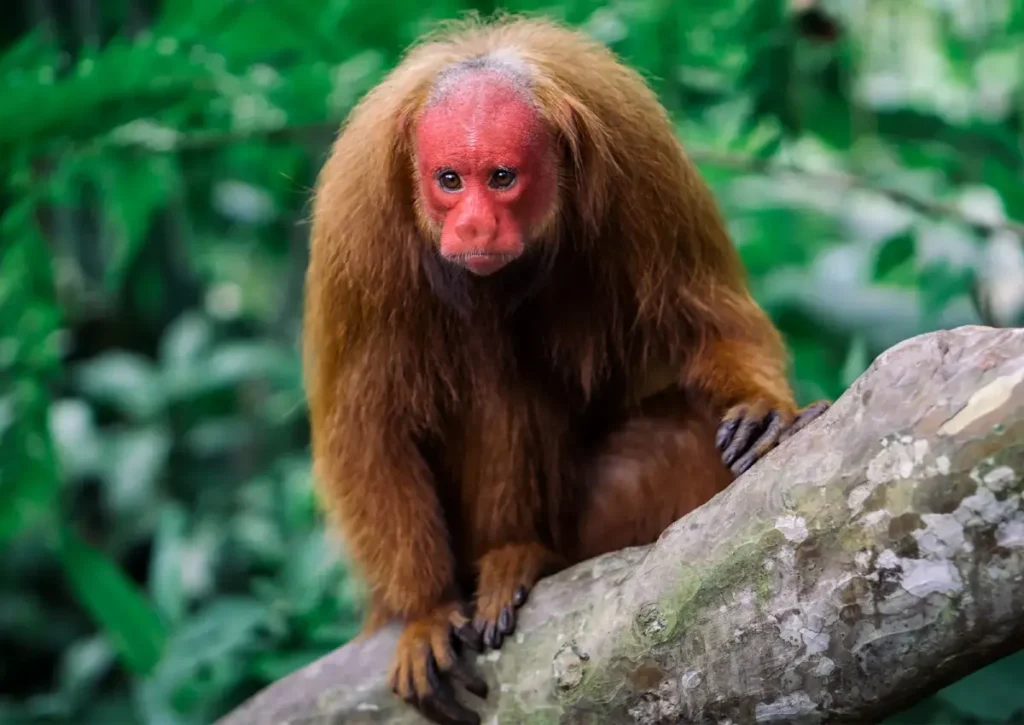
The uakari monkey is one of the most eye-catching amazon rainforest animals, instantly recognized by its bald, bright red face and short little tail. These unique primates live in social groups deep within the flooded forests, where they spend most of their time foraging for fruit among the branches. Interestingly, their red face is more than just a look—it’s a sign of good health, while a pale face can be a warning of sickness. In the wild, spotting a uakari feels like stumbling upon a strange, wise elder watching from the treetops.
Three-Toed Sloth
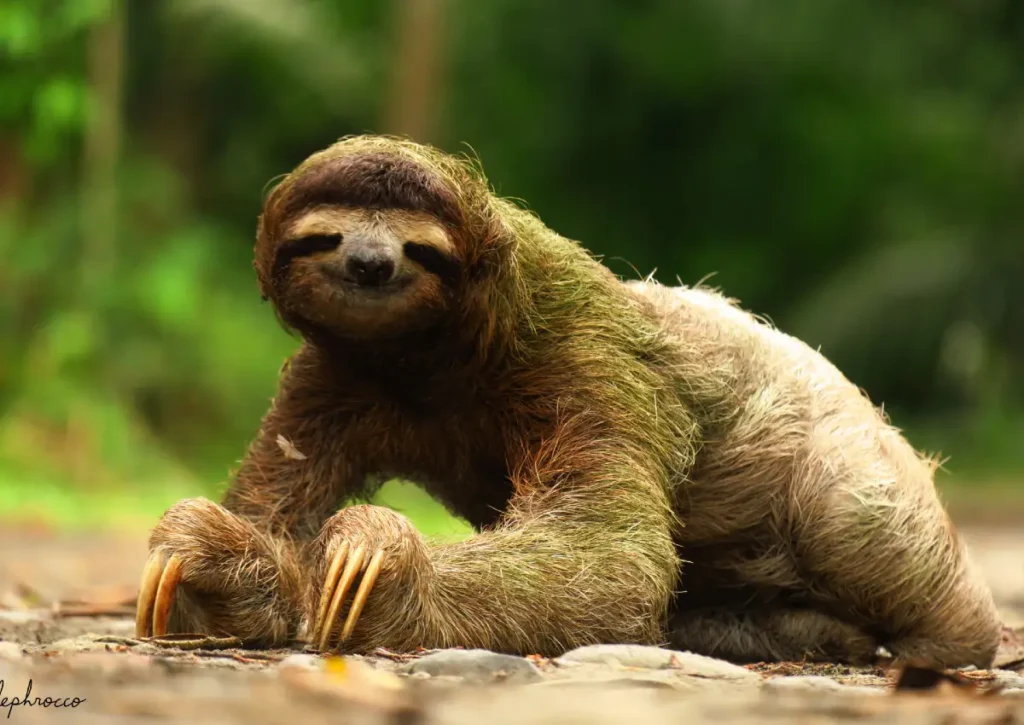
The three-toed sloth is one of the most iconic amazon rainforest animals, known for its ultra-slow movements and chill lifestyle high in the treetops. This peaceful creature spends most of its time sleeping—sometimes up to 20 hours a day—and barely moves unless it has to. Its shaggy fur isn’t just for looks; it actually hosts algae and tiny insects, which give it a greenish tint that helps it blend perfectly into the leafy canopy. It’s basically nature’s slowest ninja, camouflaged and completely unbothered.
Tamarin Monkey
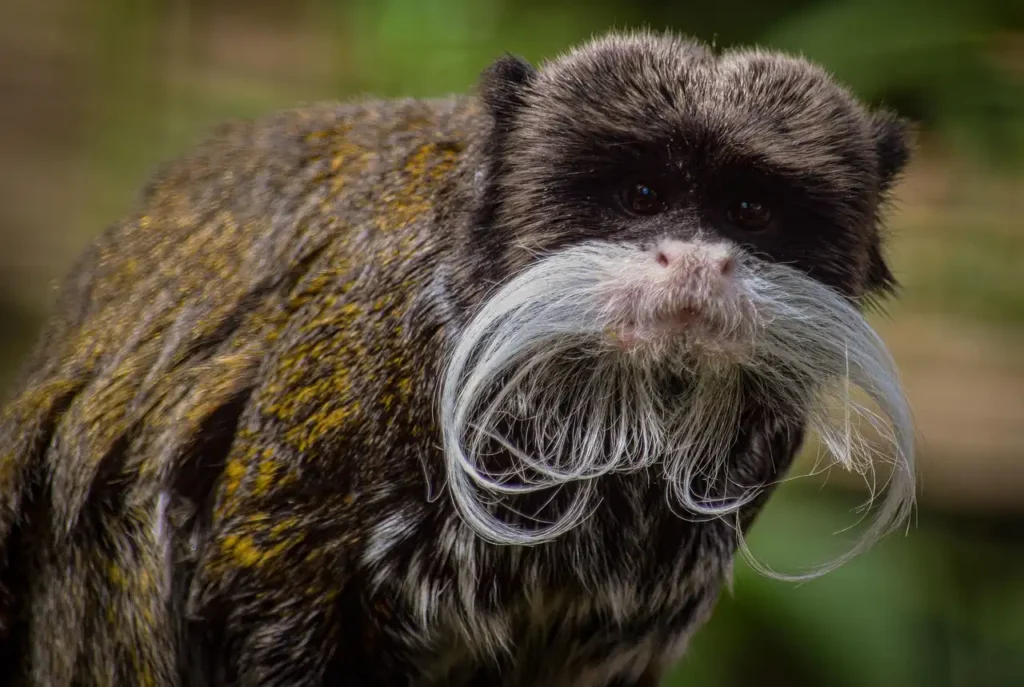
Tamarin monkeys are some of the most lively amazon rainforest animals, darting through the trees with endless energy as they search for fruit, insects, and anything else they can snack on. Despite their small size, they’ve got big personalities—and some species, like the emperor tamarin, even rock long, dramatic mustaches that make them look straight out of a storybook. With their expressive faces and bold leaps, tamarins are like tiny acrobats bringing constant motion and character to the rainforest canopy.
Tiger Cat
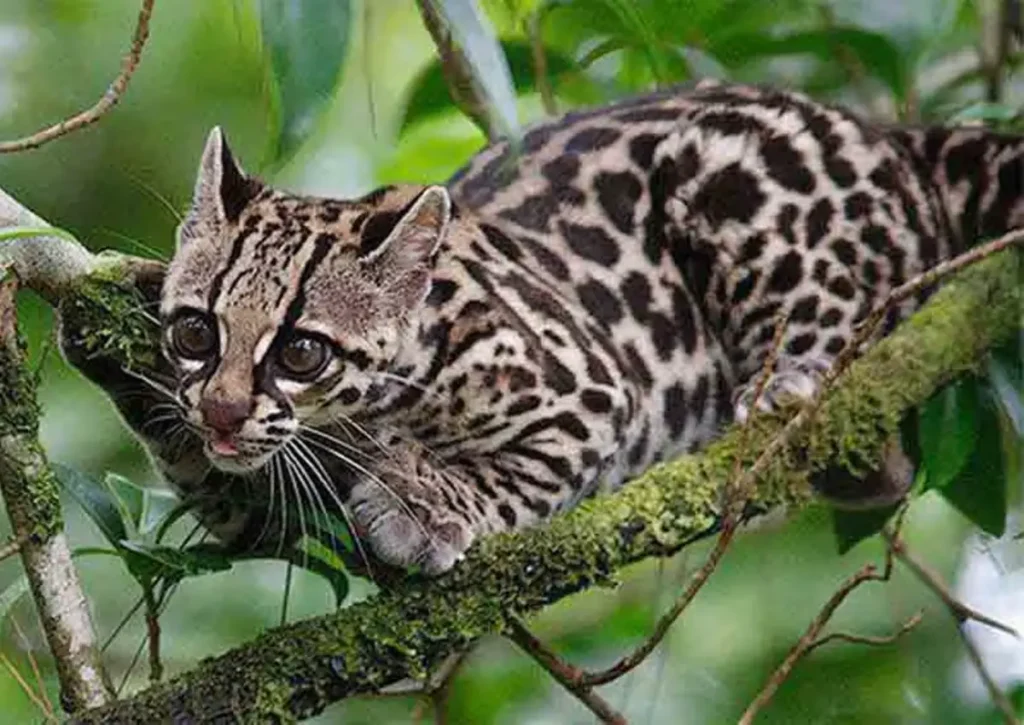
The tiger cat, also called the oncilla, is one of the most elusive amazon rainforest animals—a tiny wildcat that moves like a shadow through the dense undergrowth. As one of South America’s smallest felines, it hunts alone at night, relying on stealth and agility to catch birds, rodents, and other small prey. With its sleek spotted coat and secretive nature, the tiger cat is rarely seen, making it one of the rainforest’s most mysterious and captivating predators.
Giant Anteater
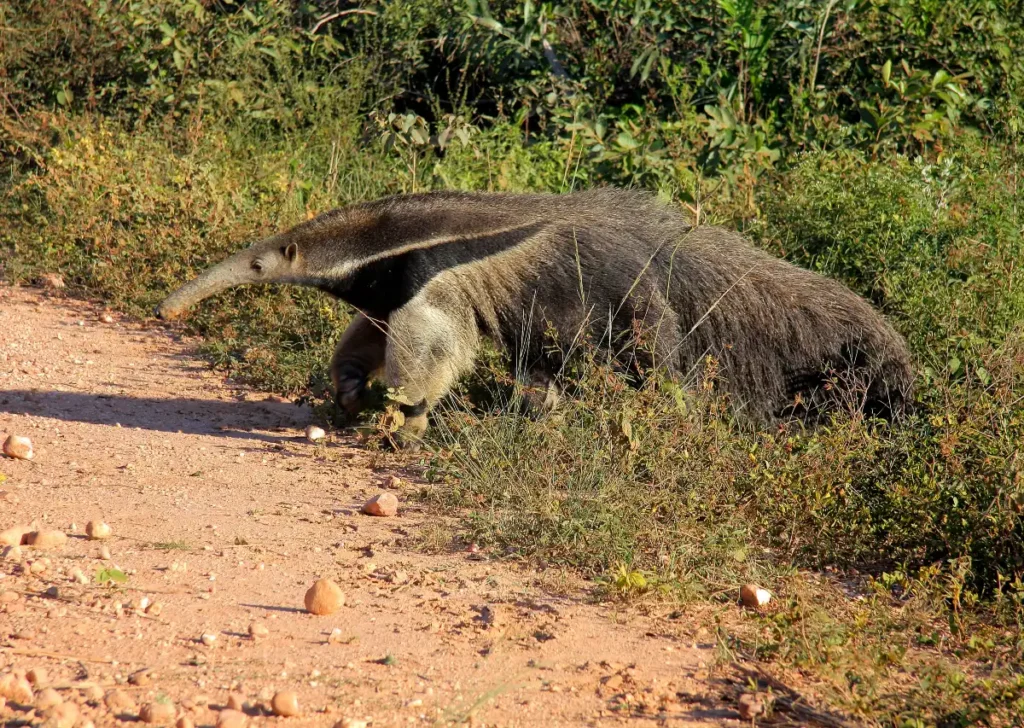
The giant anteater is one of the most unusual amazon rainforest animals, instantly recognizable by its long snout, bushy tail, and slow, deliberate walk. Found wandering grasslands and forest edges, it uses its powerful claws to tear open termite mounds and anthills, then slurps up thousands of insects with its sticky tongue that can stretch over two feet. Despite its size, it doesn’t have teeth—just an unstoppable appetite for ants. Surprisingly solitary and mostly silent, the giant anteater roams like a quiet tank, built perfectly for its strange but fascinating lifestyle.
🐦 Birds of the Amazon Rainforest
The Amazon Rainforest is home to some of the most colorful, vocal, and fascinating birds on Earth. From majestic eagles to camouflage masters, these winged creatures are vital to the jungle’s ecosystem.
Harpy Eagle
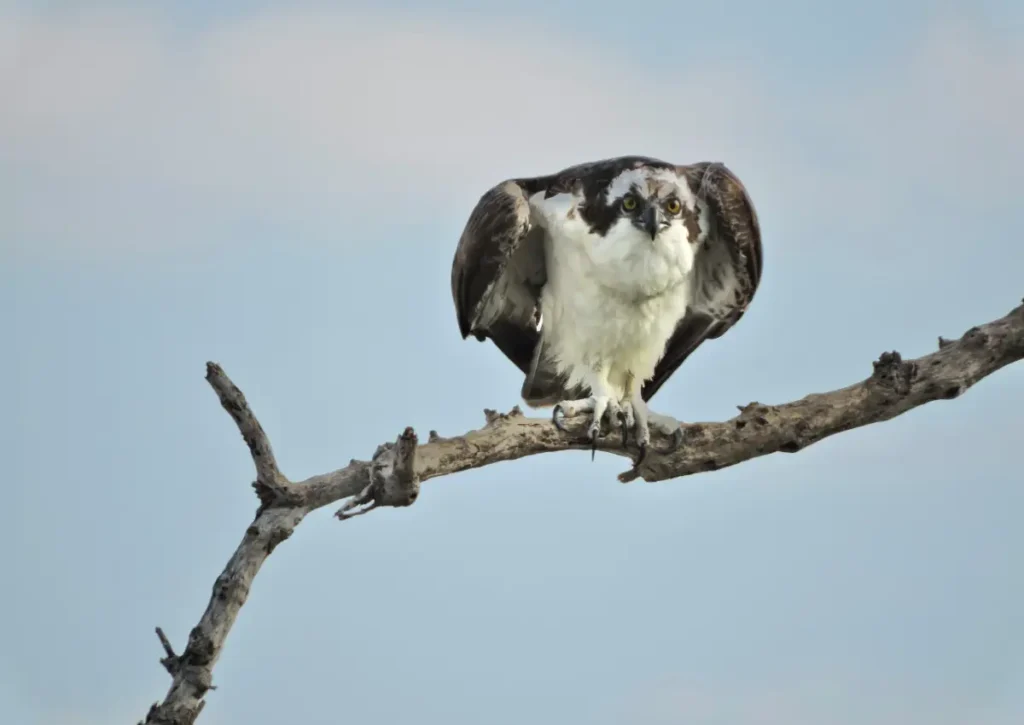
The harpy eagle is one of the largest and most powerful eagles in the world. With a wingspan over 2 meters and claws the size of a grizzly bear’s, it preys on monkeys and sloths high in the canopy. Despite its power, it’s endangered due to habitat loss. Its regal appearance and piercing eyes make it a true symbol of Amazonian wildlife.
Macaw
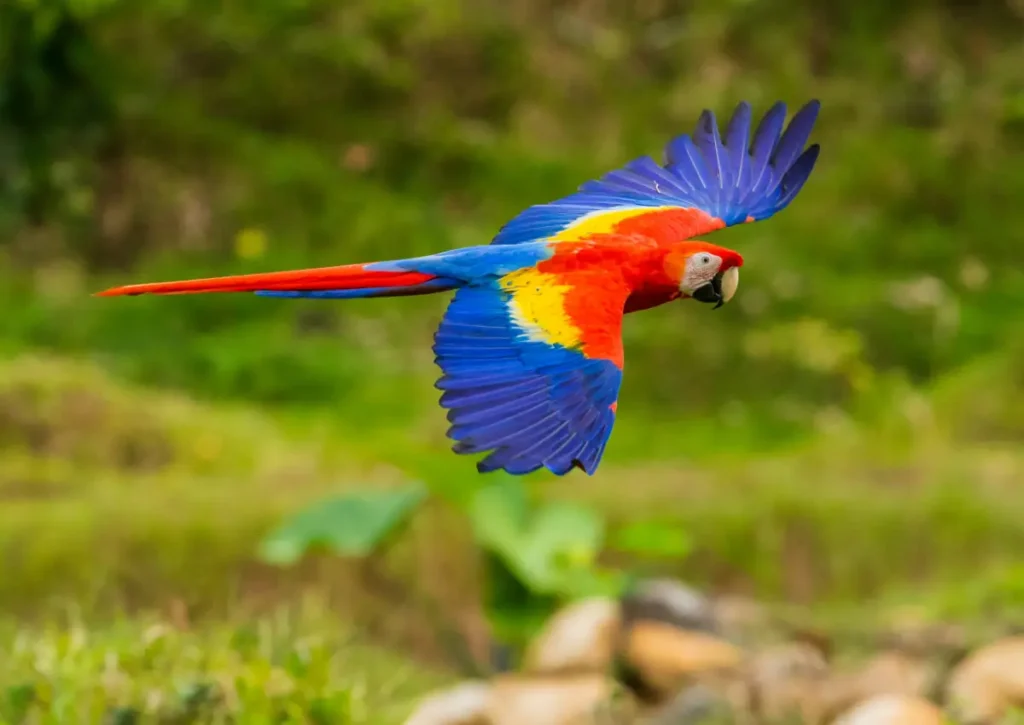
Macaws are large, brilliantly colored parrots that mate for life and communicate with loud, screeching calls. Their strong beaks crack open nuts with ease, and their intelligence makes them social and playful. Scarlet, blue-and-yellow, and green-winged macaws are among the most iconic Amazon species.
Toucan
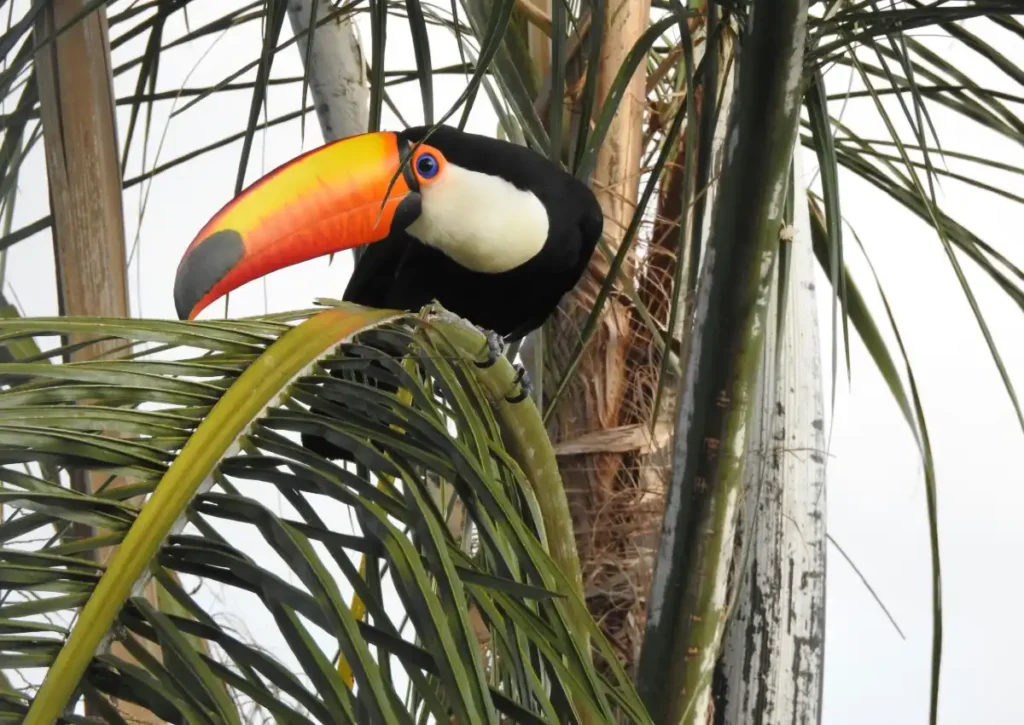
Recognizable by their oversized, rainbow-colored bills, toucans are fruit lovers that help disperse seeds throughout the forest. Their bills may look heavy, but they’re actually light and hollow. Toucans are also known for their curious and often comical behavior.
Hoatzin
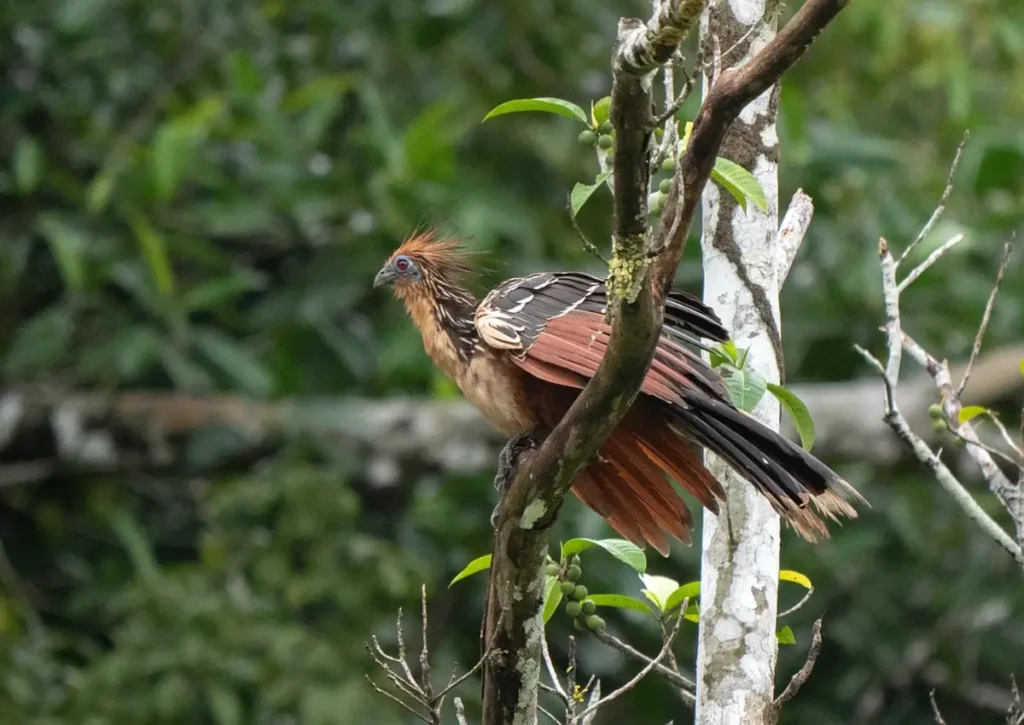
Also called the “stinkbird” due to its unique digestive system, the hoatzin ferments leaves in its crop — much like a cow. It emits a strong odor and makes clumsy movements through the branches. Chicks even have claws on their wings to climb back into nests.
Potoo
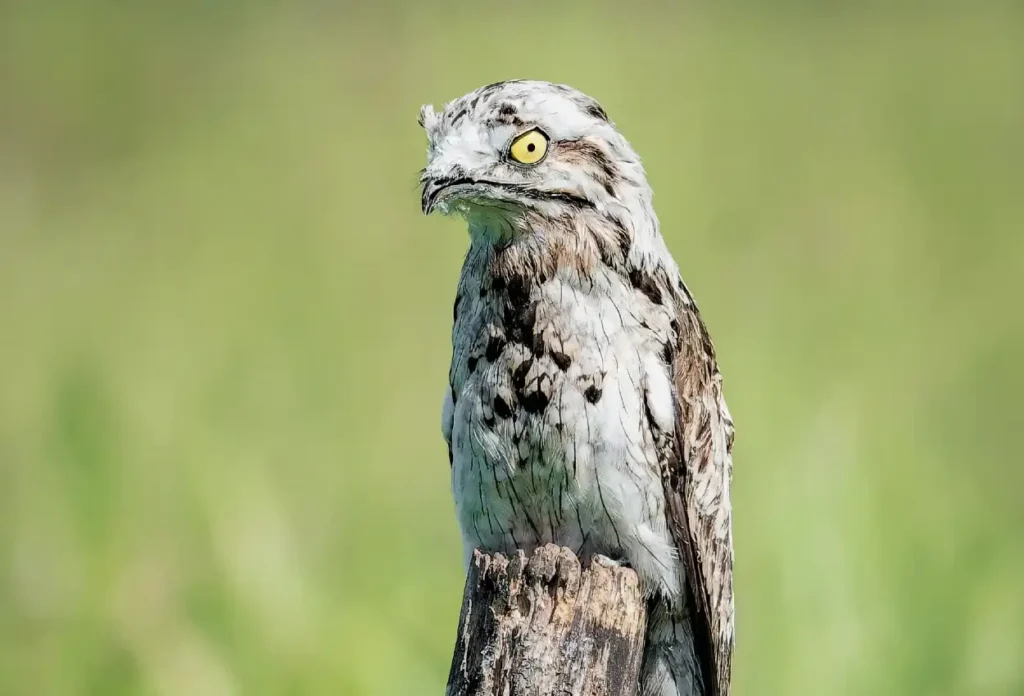
Masters of disguise, potoos perch motionless on tree stumps and branches during the day, perfectly camouflaged as dead wood. At night, they become active, catching insects mid-flight with their wide, gaping mouths and haunting cries.
Amazonian Royal Flycatcher
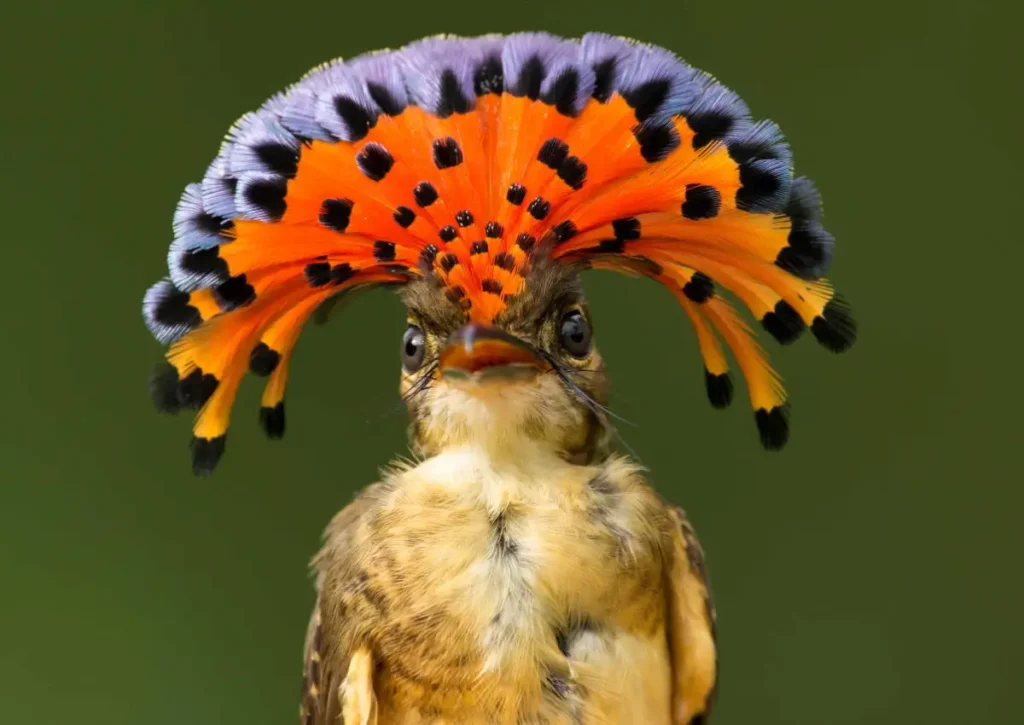
Usually seen with a plain brownish appearance, this bird reveals a spectacular red or orange fan-shaped crest during displays or moments of stress. It lives quietly in forest understories, feeding on small insects and flying prey.
Amazonian Umbrellabird
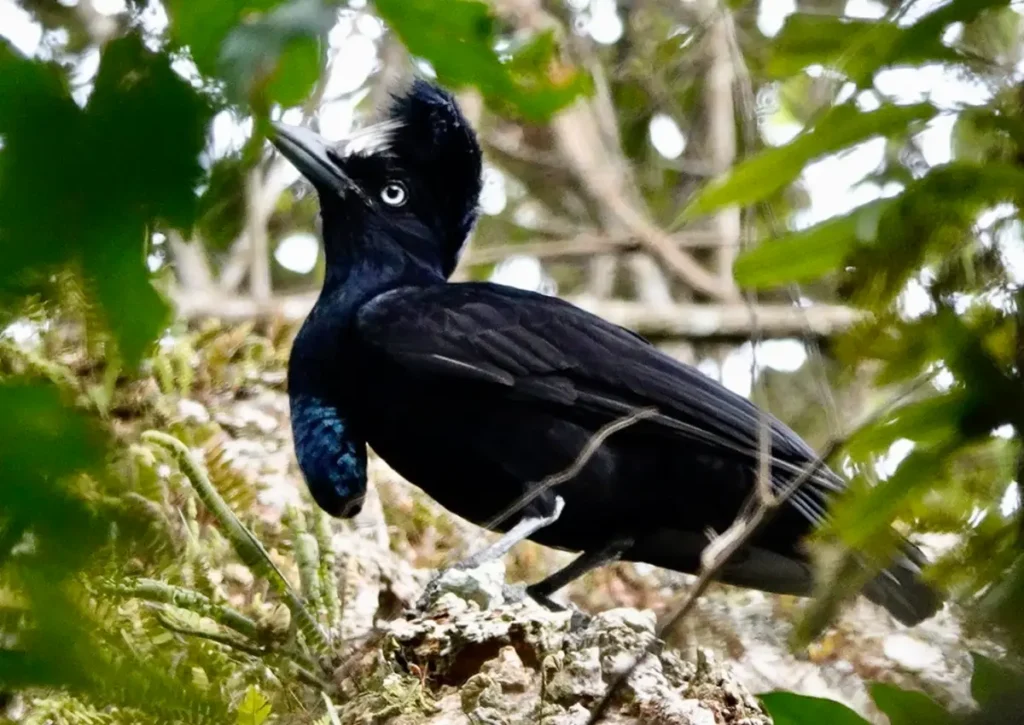
This bird gets its name from the umbrella-like crest atop its head. Males also sport a long wattle under the beak. Their low booming calls echo through the trees during mating season. Though rare, they’re a striking sight if spotted.
Spectacled Owl
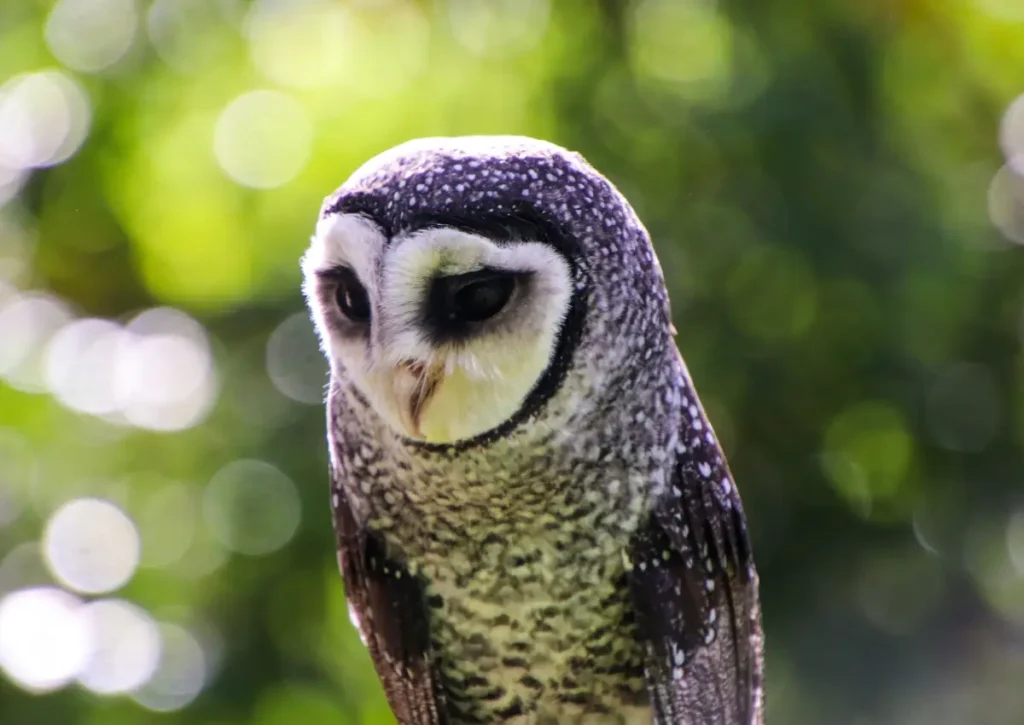
Nocturnal and silent, the spectacled owl has a distinct white facial pattern that resembles glasses. It hunts rodents and insects from perches in the forest, using excellent vision and hearing. Unlike most owls, it’s often solitary and territorial.
Amazonian Motmot
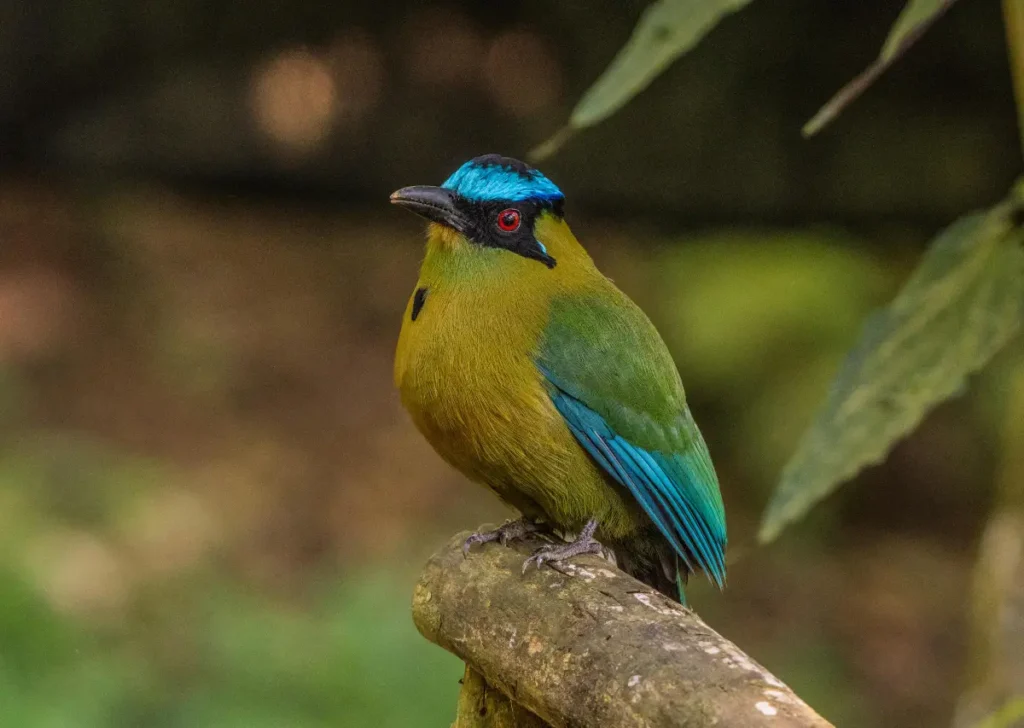
Motmots are medium-sized birds with striking blue and green plumage and racquet-tipped tails. They often sit motionless on branches before swooping down on insects or small lizards. Their quiet presence makes them a peaceful part of the Amazon soundscape.
Spix’s Macaw
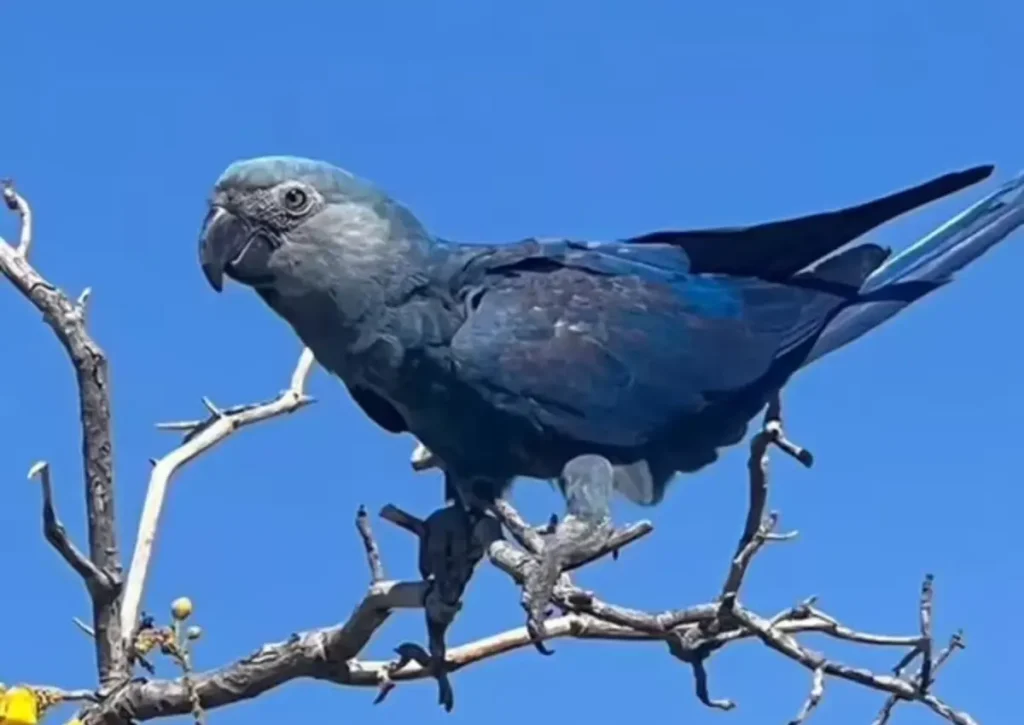
Made famous by the movie Rio, this stunning blue parrot is critically endangered and once believed extinct in the wild. Efforts to reintroduce it into its natural habitat are ongoing. It’s a symbol of both beauty and the fragility of Amazonian species.
🐍 Reptiles of the Amazon Rainforest
Reptiles are some of the most ancient and fascinating Amazon Rainforest animals. These cold-blooded creatures thrive in the dense jungle, from riverbanks to treetops, and each has a unique adaptation for survival.
Green Anaconda: The Largest Snake Among Amazon Rainforest Animals
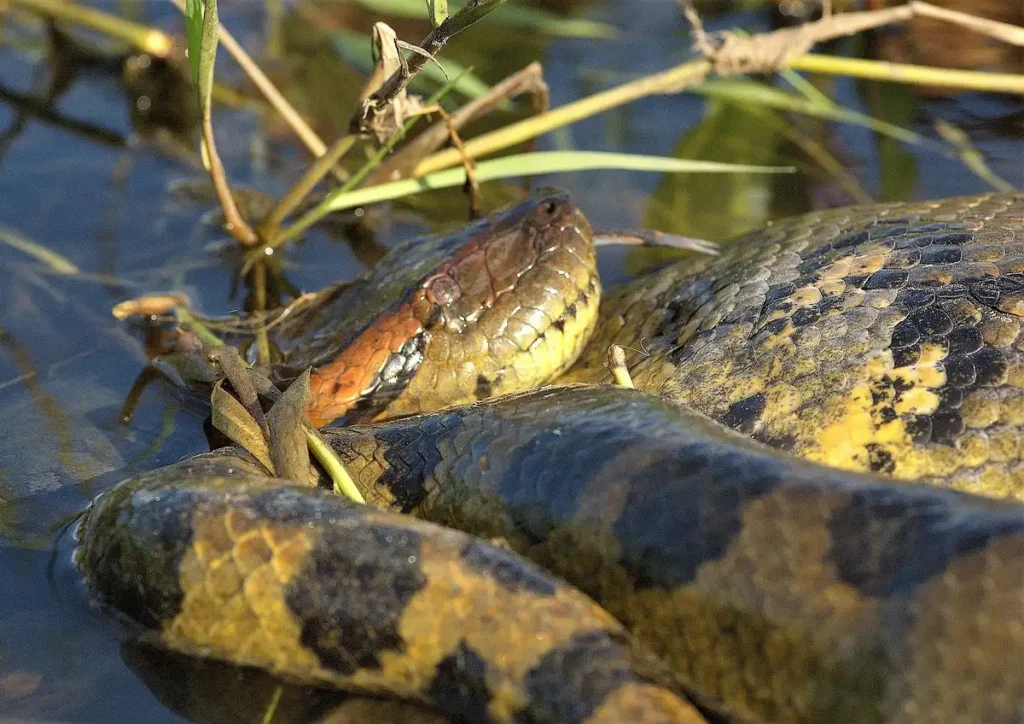
The green anaconda is one of the most iconic Amazon Rainforest animals. It lives in swamps, slow-moving rivers, and flooded forest floors. As a carnivore, it feeds on fish, birds, caimans, and even capybaras. Using powerful muscles, it coils around its prey and suffocates it before swallowing whole. A fascinating fact: females are significantly larger than males—sometimes twice their size!
Boa Constrictor: The Silent Stalker of the Jungle
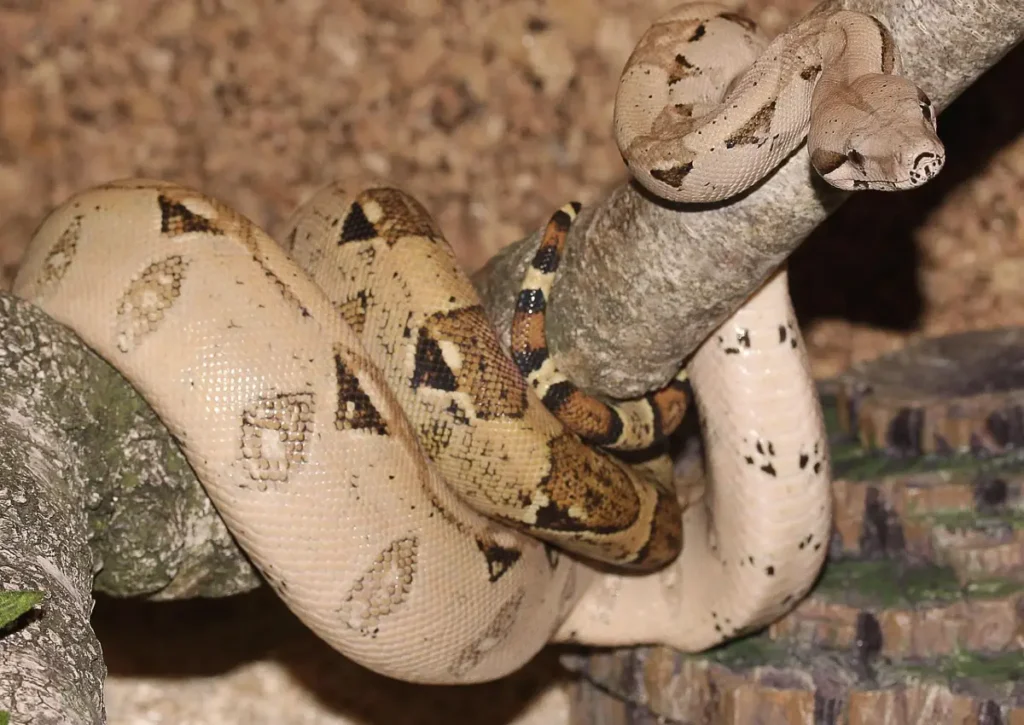
Another famous Amazon Rainforest animal, the boa constrictor lives in both trees and on the forest floor. It hunts small mammals, birds, and reptiles using ambush tactics. It kills by constriction, not venom. Curiously, boas can sense heat through pits in their face, helping them locate warm-blooded prey even in darkness.
Caiman: The Watchful Guardian of Amazonian Waters
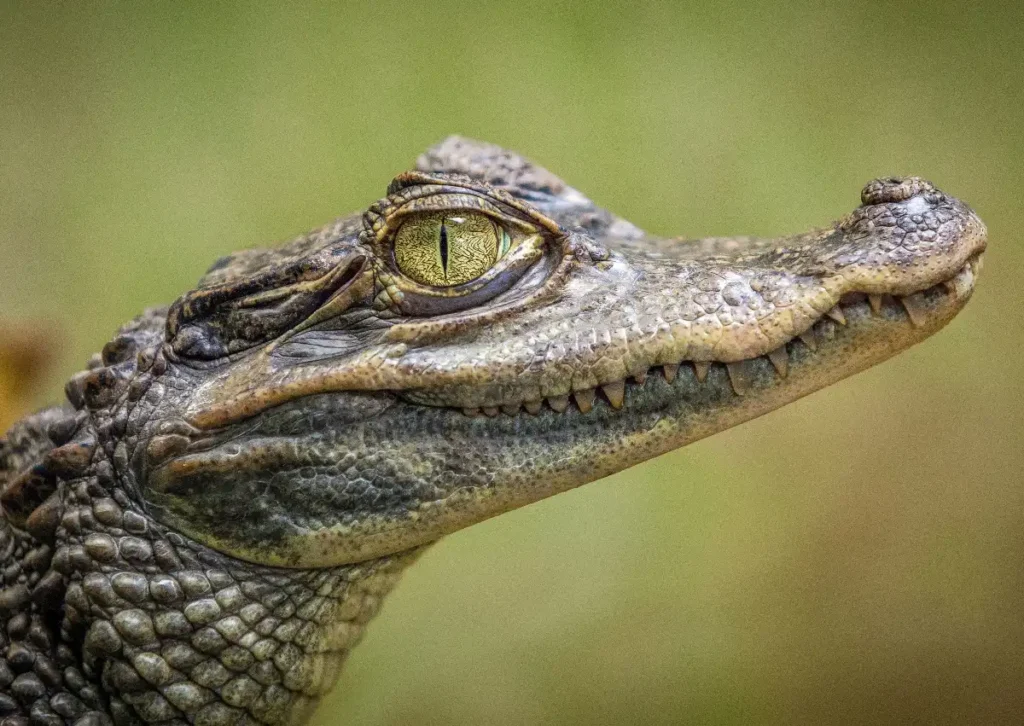
Caimans are widespread Amazon Rainforest animals that thrive in rivers, lakes, and wetlands. They eat fish, insects, and small mammals, playing a key role in aquatic food chains. These reptiles are often mistaken for crocodiles but are generally smaller. Fun fact: baby caimans make chirping sounds while still inside the egg!
Black Caiman: The Largest Predator of Amazon Waters
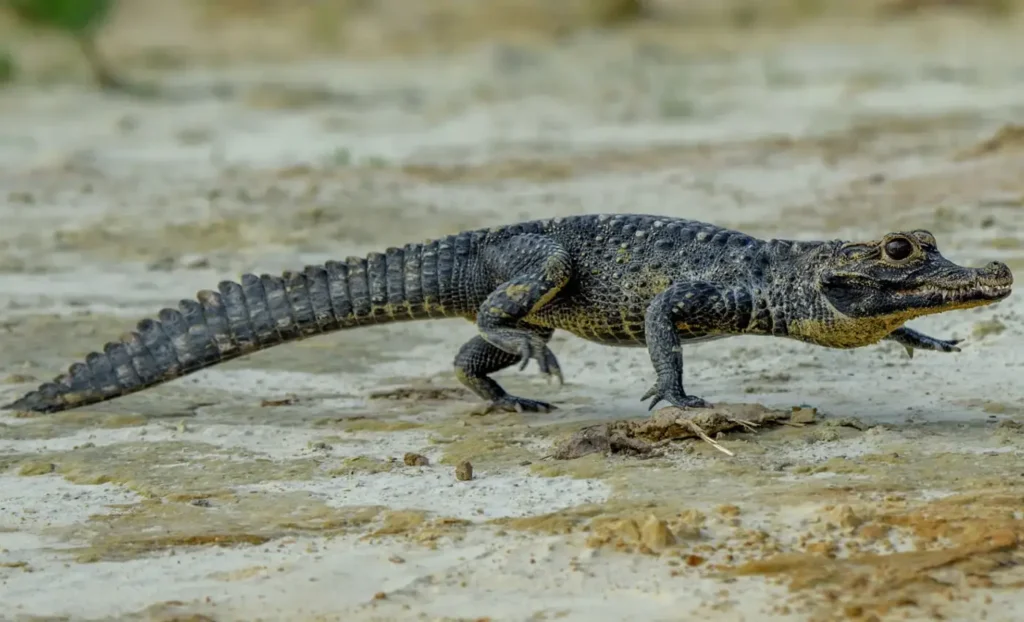
As one of the largest reptiles in the Amazon Rainforest, the black caiman is an apex predator. It inhabits slow rivers and oxbow lakes and feeds on almost anything it can catch, including fish, capybaras, and even anacondas. Unlike its lighter-colored cousins, its black skin helps it blend into murky waters at night.
Amazon Tree Boa: The Master of the Branches
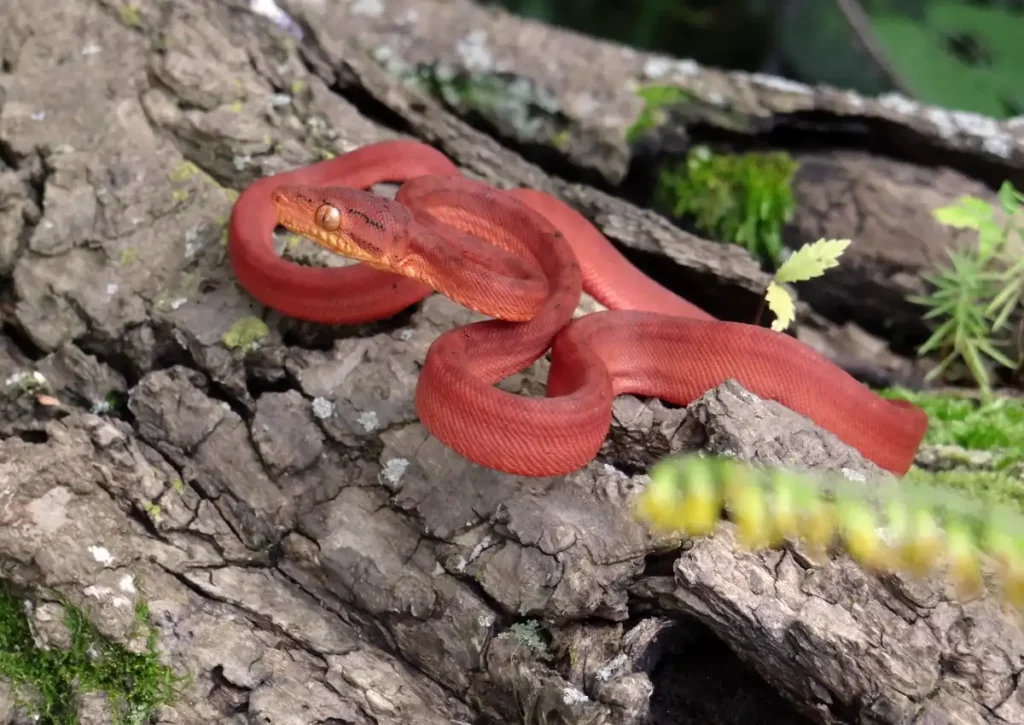
This non-venomous snake is one of the most flexible Amazon Rainforest animals. It lives high in the trees and hunts at night, feeding on birds, frogs, and lizards. Though it lacks venom, it strikes rapidly and bites hard. Its patterns vary from brown to bright orange—making each specimen truly unique.
Emerald Tree Boa: The Jewel of the Canopy

Among Amazon Rainforest animals, the emerald tree boa stands out for its vivid green color and striking white markings. It lives in the upper canopy and preys on small birds and mammals. It resembles the green tree python, but the two species evolved separately—a brilliant example of convergent evolution.
Basilisk Lizard: The “Jesus Lizard” of the Amazon
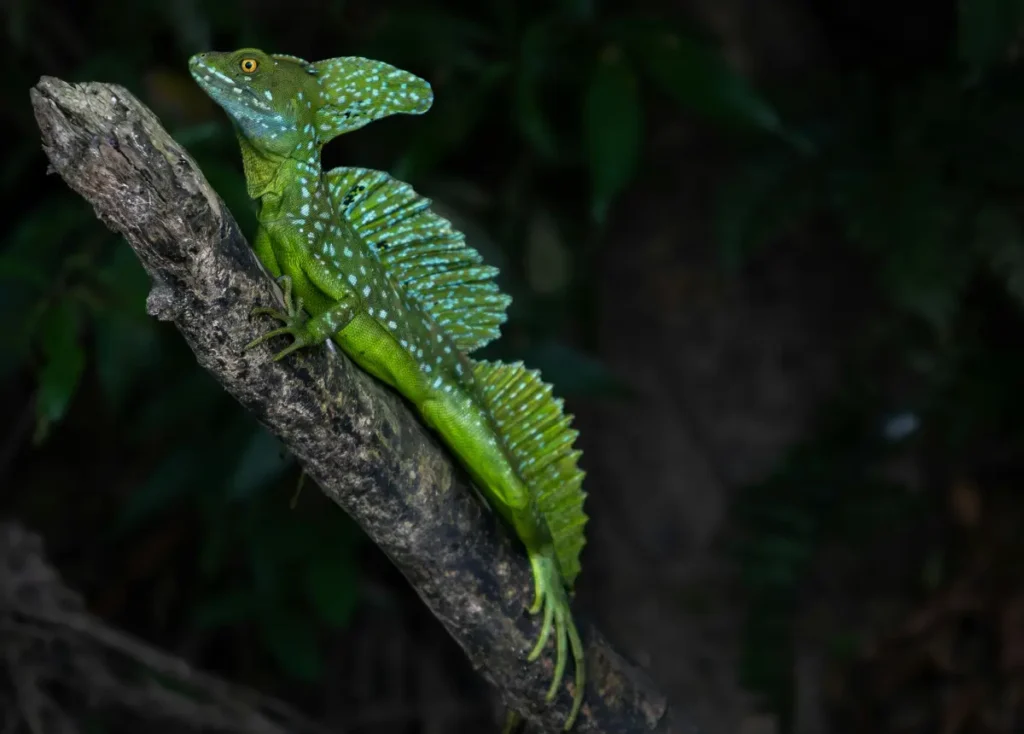
The basilisk lizard, also known as the “Jesus lizard,” is a unique Amazon Rainforest animal because of its ability to run across water. It inhabits riverbanks and moist forest floors, where it feeds on insects, flowers, and small vertebrates. Its water-walking skill helps it escape predators in a flash.
Bushmaster Snake: Deadly and Elusive
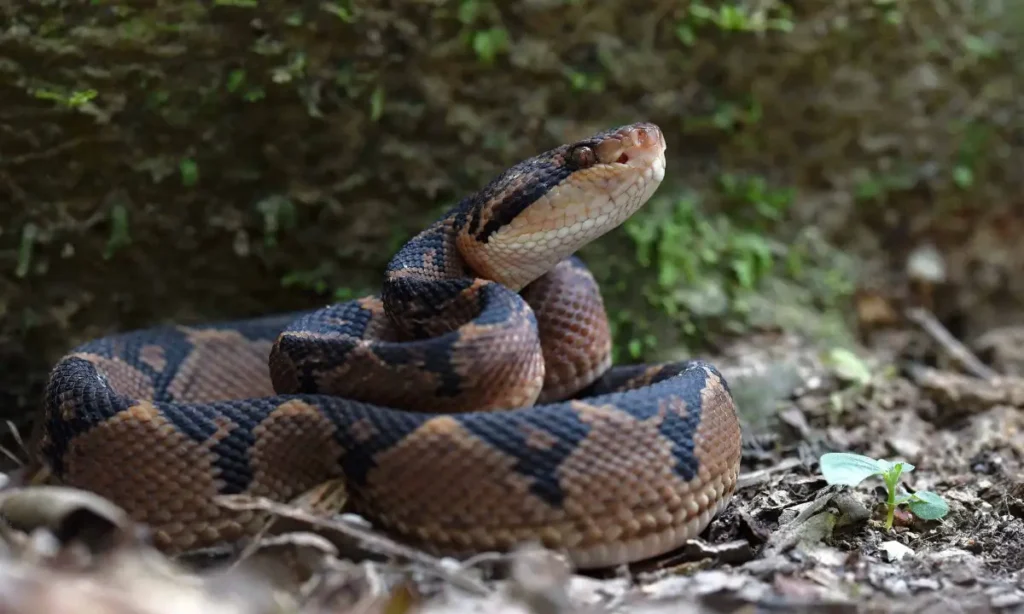
This venomous viper is one of the most dangerous Amazon Rainforest animals. The bushmaster prefers dense, undisturbed jungle and hunts rodents and birds at night. It’s the largest venomous snake in the Americas and delivers a powerful bite. Interestingly, it’s extremely shy and rarely seen despite its deadly reputation.
Green Iguana: The Herbivore of the Treetops
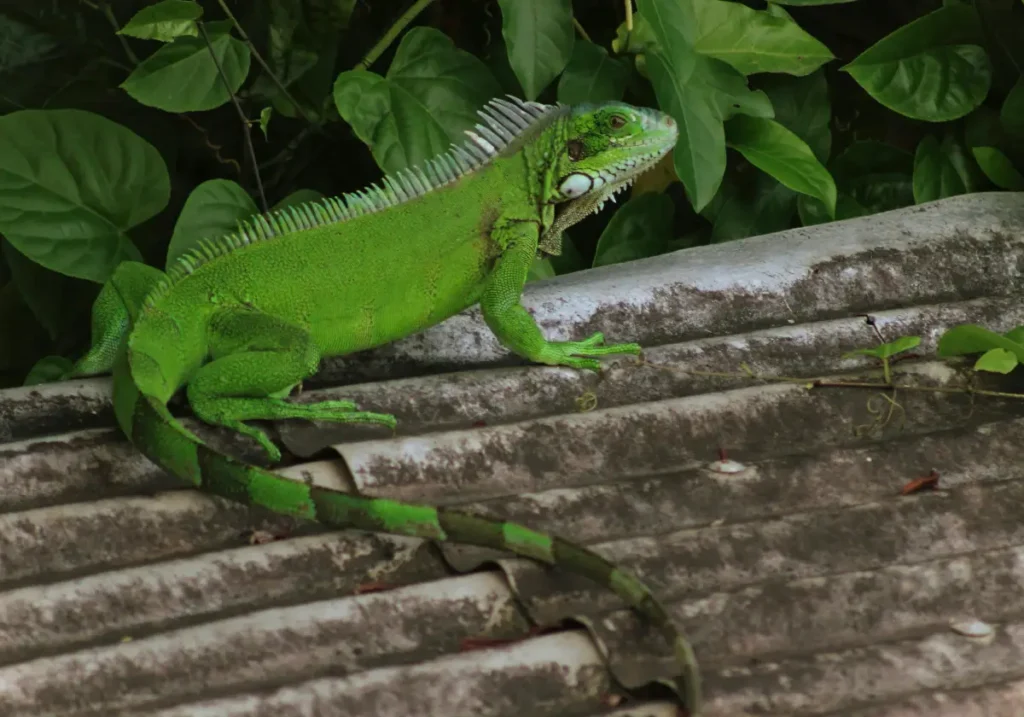
Green iguanas are peaceful, leaf-eating Amazon Rainforest animals that live high in the canopy. They feed mostly on leaves, flowers, and fruits. Their long tails and sharp claws help them navigate branches with ease. Fun fact: they can drop from great heights to escape predators—and survive the fall!
Anole Lizard: The Subtle Shape-Shifter
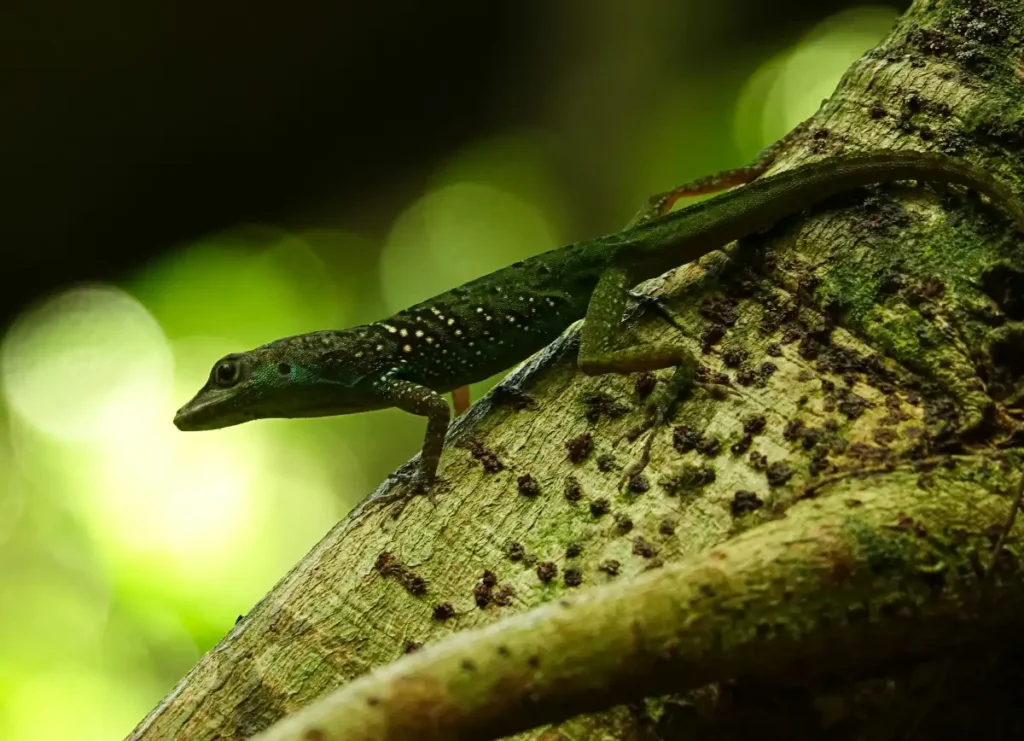
Anoles are small, agile lizards that dwell in the lower canopy and forest floor. They eat insects and spiders. Some species can subtly change color to blend with their surroundings—although not as dramatically as chameleons. Their throat fans (dewlaps) are used in territorial displays and courtship.
🐸 Amphibians of the Amazon Rainforest
Though small and often hidden, amphibians are essential Amazon Rainforest animals. Their skin breathes, their calls echo through the forest, and their colors can warn—or deceive.
Poison Dart Frog: The Most Colorful of Amazon Rainforest Animals
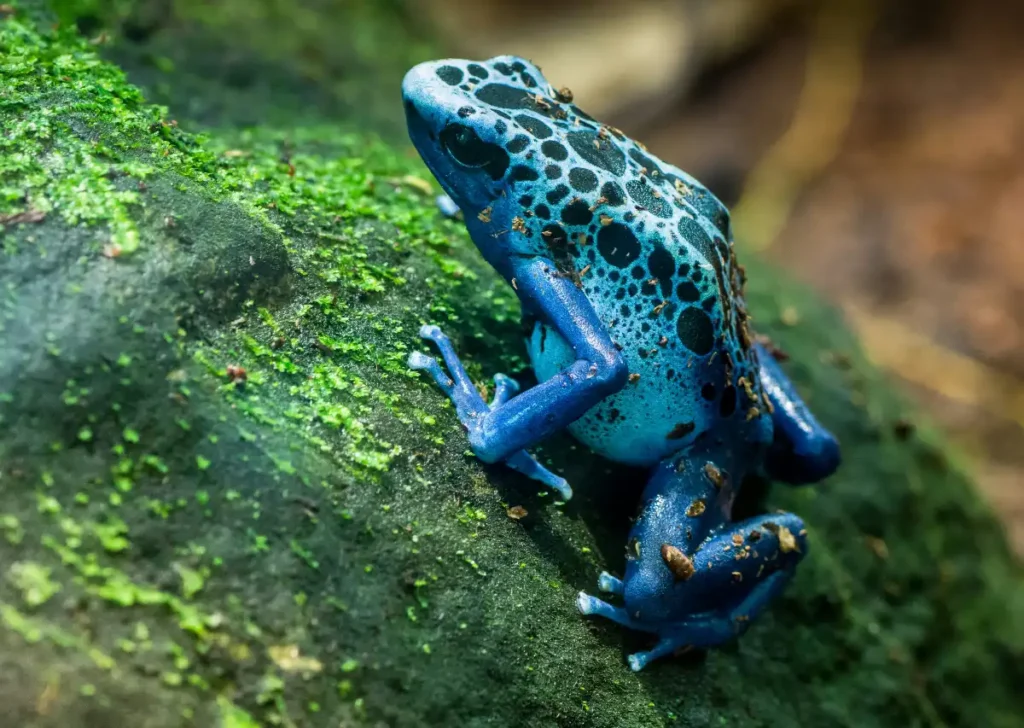
Poison dart frogs are among the most visually striking Amazon Rainforest animals, with electric hues of blue, yellow, red, and green. These tiny amphibians inhabit the humid forest floor and lower vegetation, especially near streams. They feed on ants, mites, and small insects. Their bright colors serve as a warning: many species carry toxins powerful enough to deter, or even kill, predators. Interestingly, captive-bred dart frogs raised on non-toxic diets don’t produce poison—proving that their deadly defense comes from their wild food sources.
Glass Frog: Nature’s Transparent Marvel
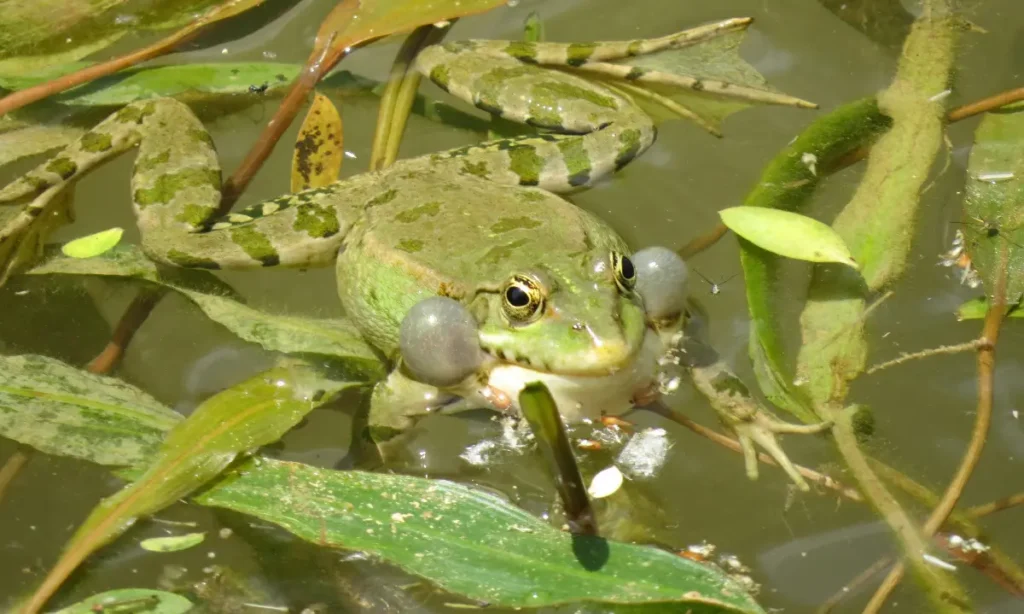
The glass frog is a delicate Amazon Rainforest animal known for its translucent skin, which allows you to see its beating heart and internal organs. It lives on leaves above running water in the rainforest understory. These nocturnal creatures feed on tiny insects like flies and gnats. During the rainy season, males call loudly to attract mates and guard fertilized eggs laid on leaves. A curious fact: some species show paternal care, with males keeping eggs moist until they hatch and drop into the stream below.
🐜 Insects & Arthropods of the Amazon Rainforest
Often overlooked because of their size, insects and arthropods are some of the most abundant and fascinating Amazon Rainforest animals. They play essential roles in pollination, decomposition, and even defense.
Bullet Ant: The Most Painful Sting Among Amazon Rainforest Animals
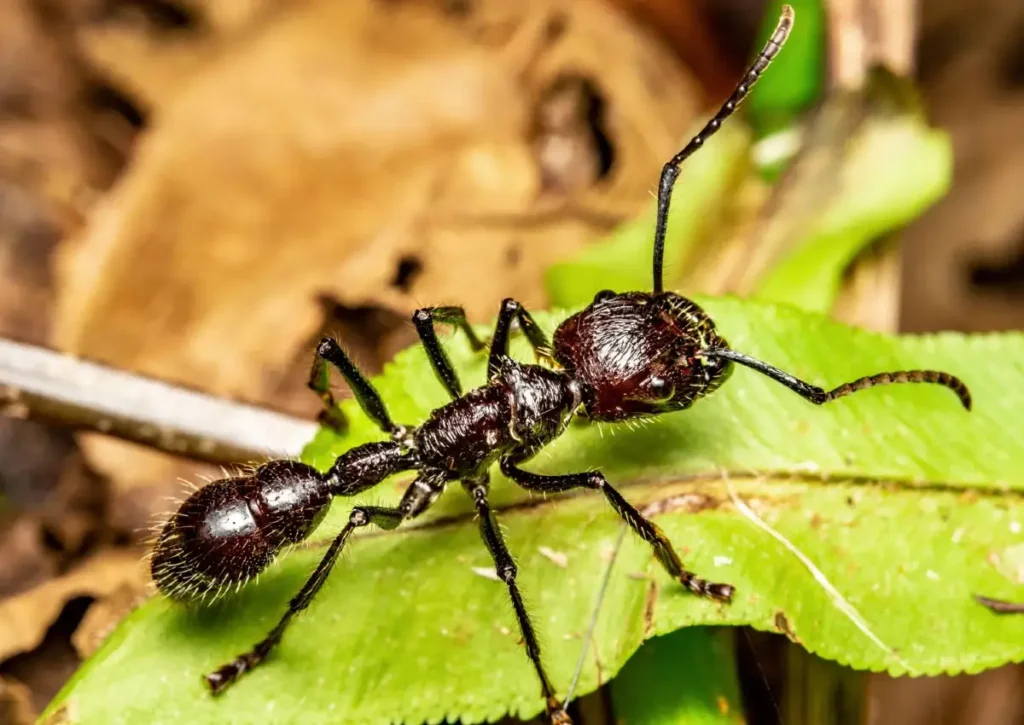
The bullet ant is infamous among Amazon Rainforest animals for delivering the most painful insect sting in the world—described as equal to being shot by a bullet. These large black ants live in the forest floor and low vegetation. They feed on nectar, small insects, and tree sap. Bullet ants are extremely territorial and aggressive when provoked. A fascinating fact: some Amazonian tribes use them in painful coming-of-age rituals to test endurance and bravery.
Tarantula: The Hairy Hunter of the Jungle
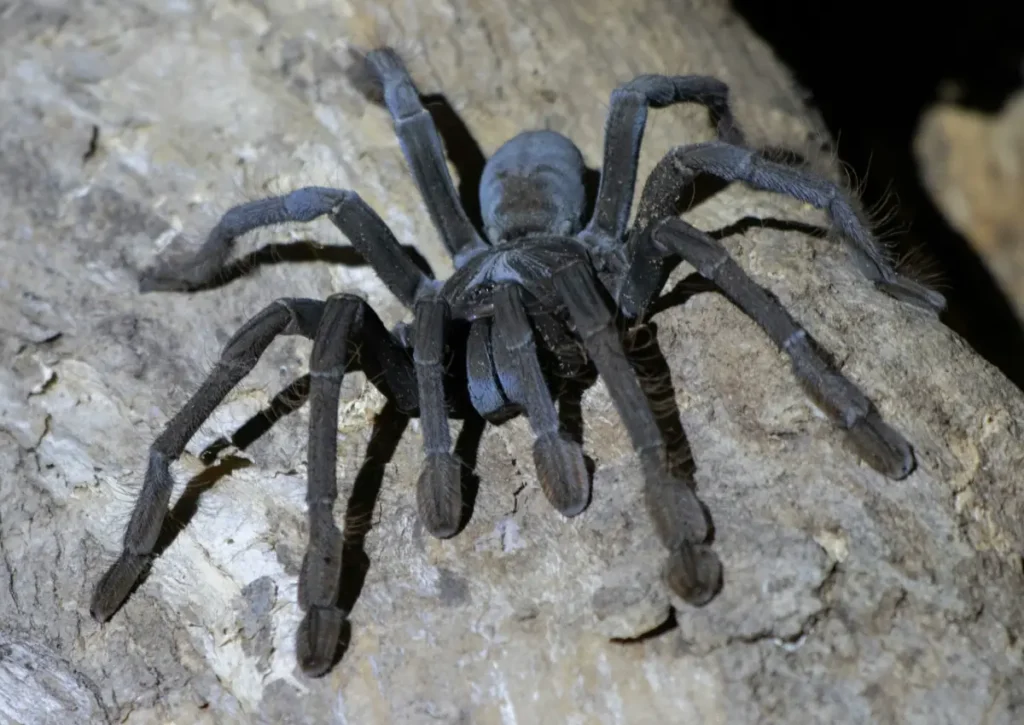
Tarantulas are one of the most recognizable Amazon Rainforest animals, often found in burrows or hiding under logs and leaves. They feed on insects, small frogs, and even birds using their venomous bite. While their appearance is intimidating, they are generally not dangerous to humans. One curious fact: when threatened, some tarantulas release tiny barbed hairs that irritate predators’ skin and eyes—an unusual and effective defense.
Leafcutter Ant: The Farmers of the Amazon Rainforest
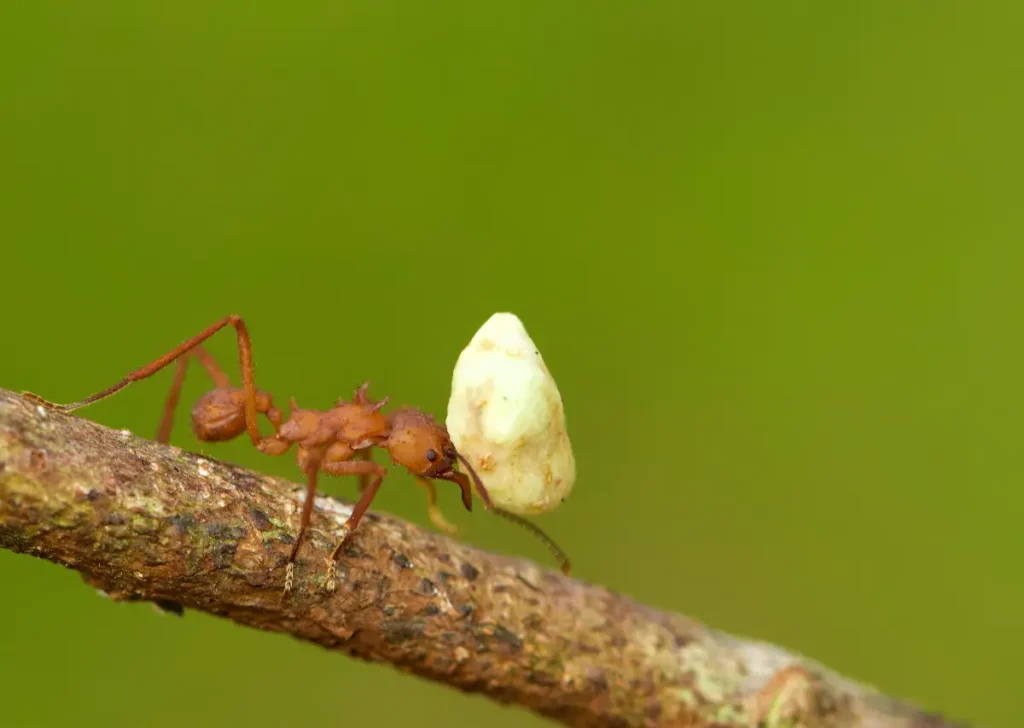
Among the most organized Amazon Rainforest animals, leafcutter ants live in colonies of millions. They’re often seen carrying leaf fragments much larger than their bodies. Interestingly, they don’t eat the leaves directly; instead, they use them to grow a special fungus underground, which serves as their food. Their elaborate tunnels and teamwork are so advanced, scientists compare them to human agriculture and city planning.
Blue Morpho Butterfly: A Flash of Color in the Canopy
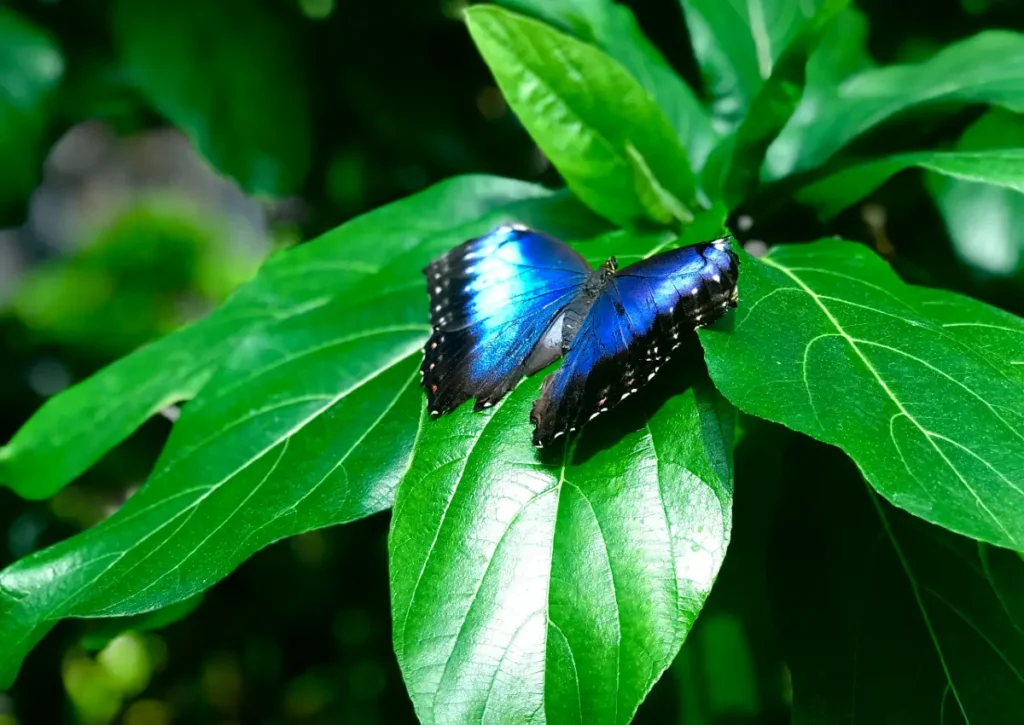
The blue morpho butterfly is one of the most dazzling Amazon Rainforest animals. Its bright, iridescent wings reflect sunlight like mirrors as it flutters through the understory and canopy. It feeds on fermenting fruit, tree sap, and rotting plants. When at rest, the dull brown underside of its wings camouflages it from predators. Fun fact: its wing scales scatter light in a way that produces its metallic blue color—an optical illusion rather than pigment.
Amazonian Giant Centipede
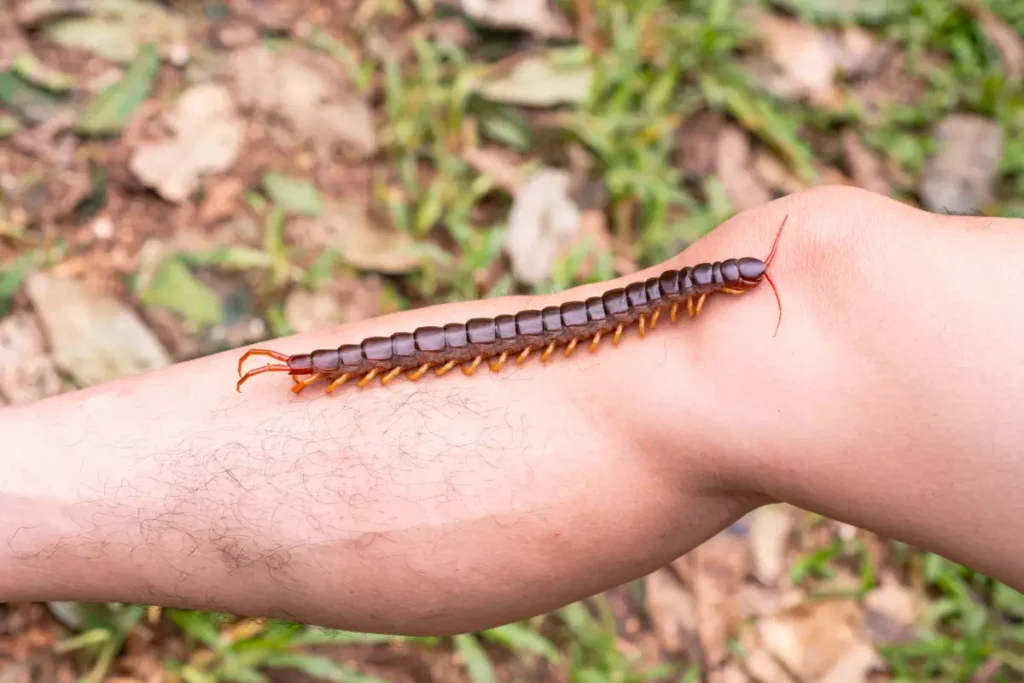
This massive arthropod can grow over 30 cm long and is one of the most fearsome invertebrate Amazon Rainforest animals. It lives in damp leaf litter, under rocks, and in fallen logs. It preys on insects, frogs, lizards, and even birds by injecting venom through sharp pincers. A chilling fact: its bite is powerful enough to subdue animals several times its size, making it a top predator in its category.
🐟 Fish of the Amazon Rainforest
Rivers, lakes, and flooded forests in the Amazon basin are home to thousands of unique fish species. These aquatic Amazon Rainforest animals display incredible adaptations—from electricity to bone-crushing bites
Piranha: The Sharp-Toothed Icon of Amazon Rainforest Animals
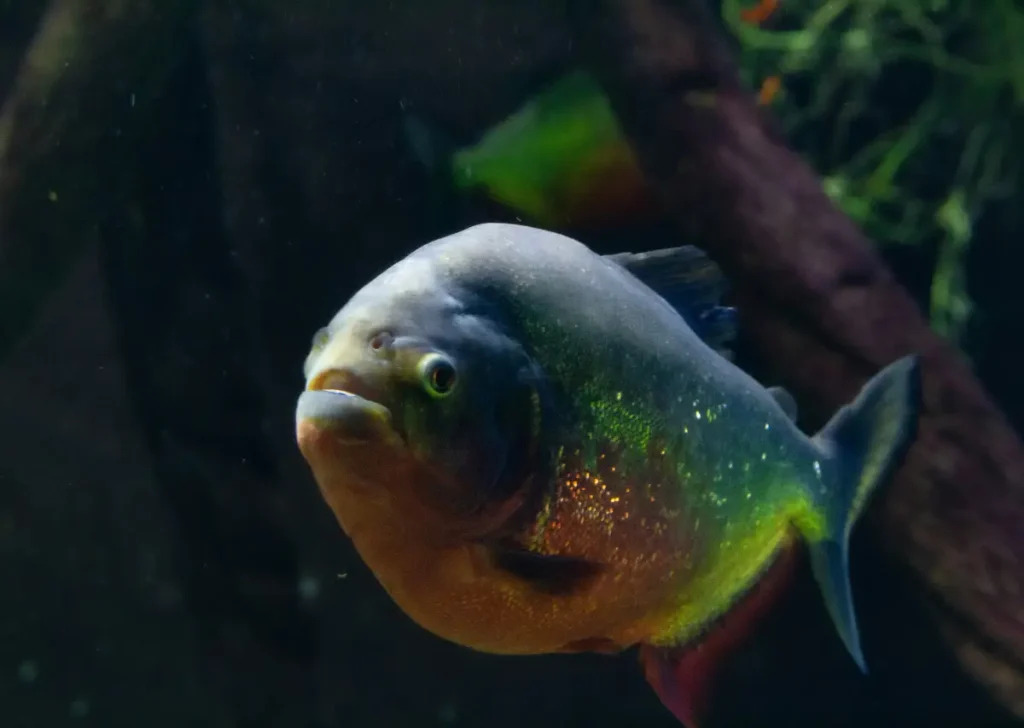
Piranhas are among the most well-known Amazon Rainforest animals thanks to their razor-sharp teeth and fearsome reputation. They inhabit slow-moving rivers and flooded forests. Most species are omnivores, feeding on insects, small fish, fruits, and even carrion. While group feeding frenzies do occur, they’re more common during droughts when food is scarce. Fun fact: piranhas communicate using barking or clicking sounds underwater.
Red-Bellied Piranha: The Most Aggressive of Its Kind
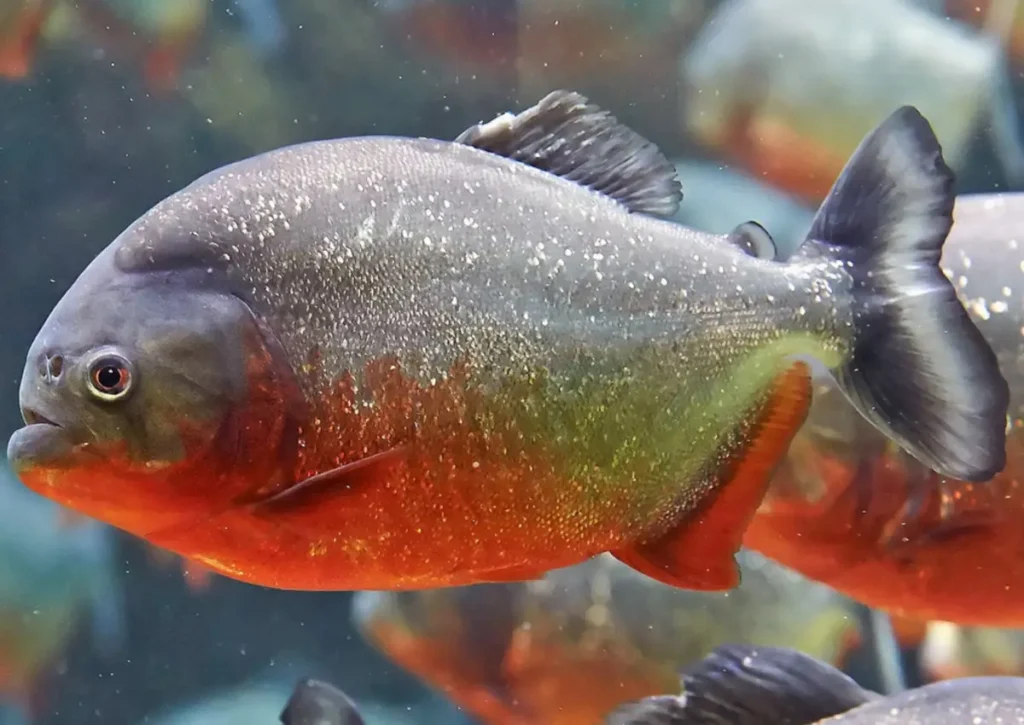
One of the most aggressive Amazon Rainforest animals, the red-bellied piranha is easily identified by its reddish lower body and muscular build. It’s a scavenger and predator, feeding on fish, insects, and the occasional mammal. These fish usually travel in schools for protection rather than hunting. Curiously, their bite force rivals that of sharks, relative to their body size.
Arapaima: The Giant of Amazonian Waters
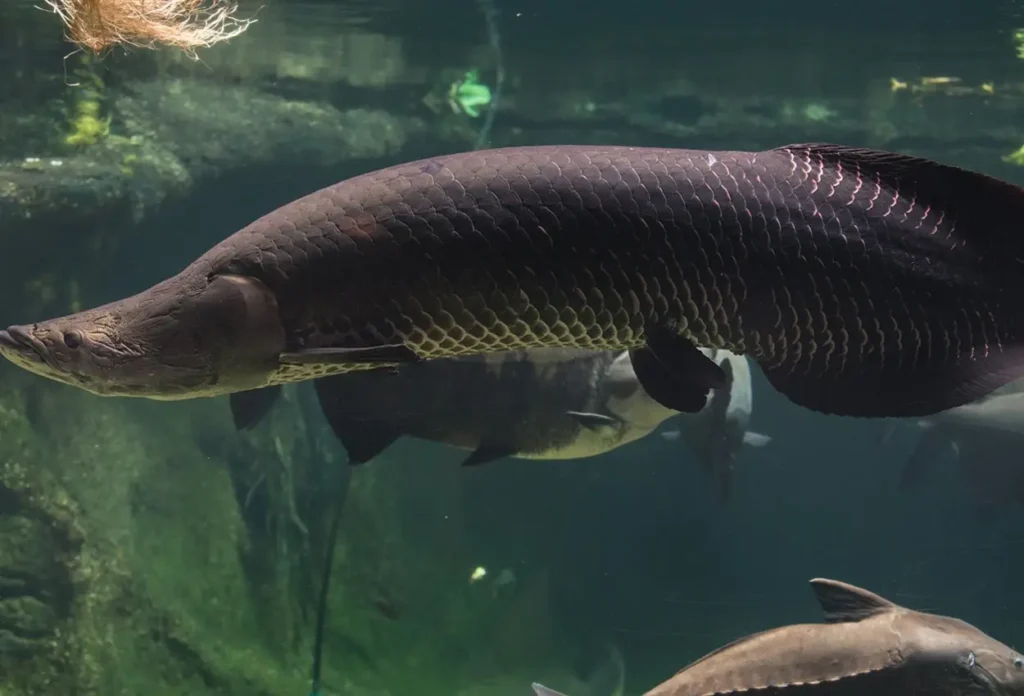
The arapaima is one of the largest freshwater fish in the world and a true heavyweight among Amazon Rainforest animals. It inhabits slow rivers, oxbow lakes, and flooded forests. It feeds on fish, crustaceans, and sometimes birds or small mammals. Its most fascinating trait? It can breathe air thanks to a modified swim bladder, allowing it to survive in oxygen-poor waters.
Electric Eel: The Shock Specialist of the Amazon
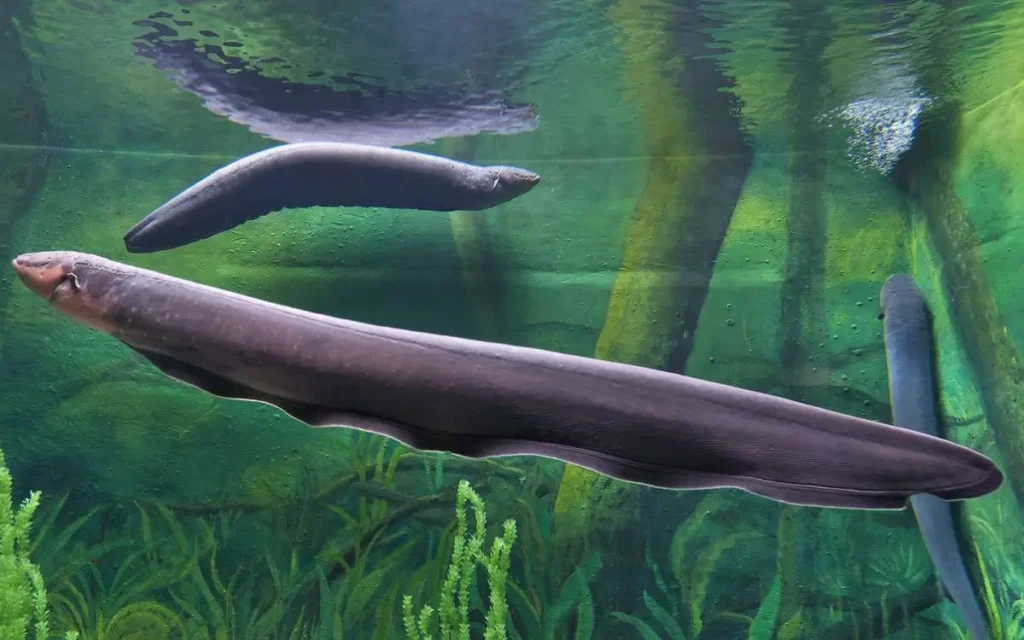
Despite its name, the electric eel is more closely related to catfish. This Amazon Rainforest animal lives in murky rivers and flooded forests, where it uses electric shocks to hunt prey like fish, frogs, and small mammals. It can produce up to 600 volts—enough to stun or even kill. Amazingly, it also uses weaker electric pulses to navigate and communicate.
Pacu: The Fruit-Eating Cousin of the Piranha
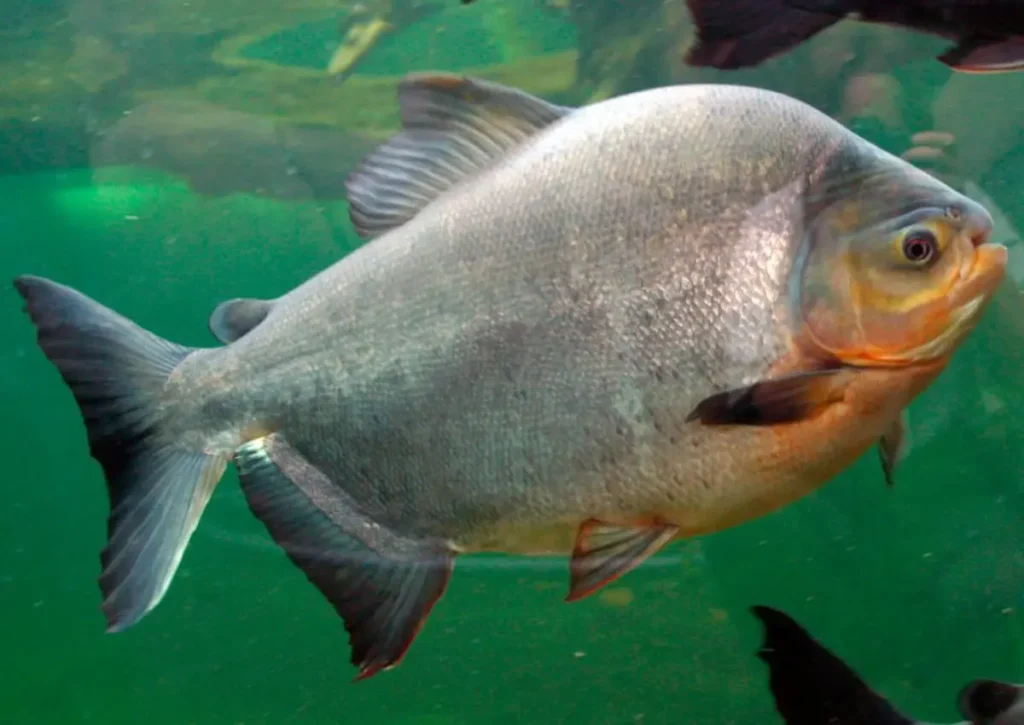
Pacus may look like piranhas, but they’re peaceful herbivores that mainly eat fruit, seeds, and nuts that fall from trees. They live in slow-flowing rivers and flooded forests. What sets them apart is their human-like, square teeth adapted for grinding plant material. Fun fact: some pacus grow so large they’ve earned the nickname “vegetarian piranhas.”
Peacock Bass: The Fierce Fighter of the Amazon
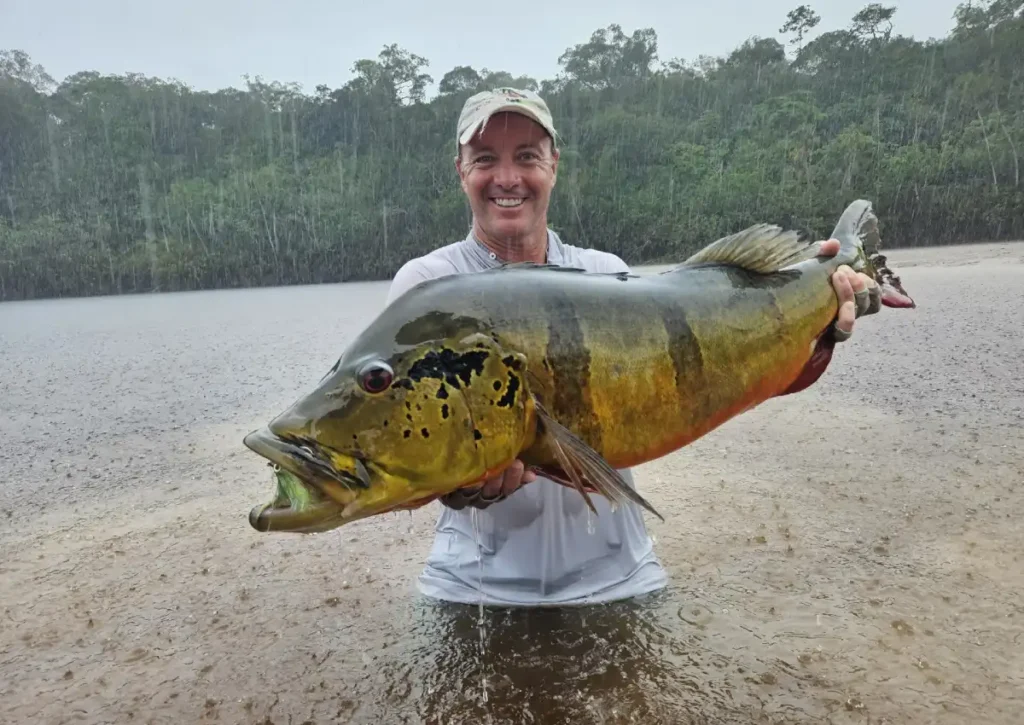
A prized catch for sport fishers, the peacock bass is one of the most aggressive predatory fish among Amazon Rainforest animals. It inhabits clearwater and blackwater rivers and preys on smaller fish and aquatic invertebrates. Its colorful body, marked with an eye-shaped spot near the tail, gives it its name. Known for its strength, it puts up a tough fight when hooked.
⚠️ Dangerous Amazon Rainforest Animals
While the Amazon is full of life and wonder, it also hides a few creatures that can truly take your breath away—in more ways than one. In this section, we explore the most dangerous Amazon Rainforest animals, not through fear, but with respect for their role in nature.
Not All Amazon Animals Are Friendly
Most rainforest wildlife avoids human contact. But a few species, whether due to venom, strength, or territorial instinct, stand out as truly dangerous. And they don’t always look the part. Some of the most hazardous Amazon jungle species are silent, camouflaged, or even beautiful.
Whether it’s a jungle creature hiding in the canopy or a deadly swimmer below the river’s surface, the real danger in the Amazon lies in the unexpected. These animals in the Amazon remind us that survival here means being alert, aware, and humble.
Stealth and Strength in the Jungle
Among the most feared predators is the jaguar—a powerful and elusive big cat. While rarely seen, it’s one of the most efficient hunters in the jungle. With its ability to kill in a single bite, it sits at the top of the Amazon animals food chain.
Then there’s the green anaconda, often called the silent giant of the river. With no venom, it still manages to be terrifying due to its sheer size and muscle. It coils around prey silently in dark waters—one of the reasons it’s among the most feared rainforest creatures.
Small Creatures, Big Threats
Don’t let their size fool you. The poison dart frog fits in your palm, yet contains enough toxins to kill multiple people. Its colorful skin is nature’s warning sign. Equally deceptive is the Brazilian wandering spider—a nocturnal hunter known for powerful venom and sudden movements.
These smaller Amazon jungle animals aren’t likely to attack humans unless provoked—but their existence shows just how diverse and unpredictable the rainforest can be.
Safety Through Knowledge
If you’re planning to experience the jungle through guided tours, you’re already doing the smartest thing. Local experts know how to avoid dangerous encounters while helping you spot incredible Amazon Rainforest animals safely and respectfully.
The jungle doesn’t have to be feared—it has to be understood. Because even its most dangerous residents play an essential role in keeping this incredible ecosystem balanced.
❓ FAQs About Amazon Rainforest Animals
Curious about the incredible wildlife in the Amazon? Here are some of the most common questions people ask about Amazon Rainforest animals, answered simply and clearly.
1. What is the most dangerous animal in the Amazon Rainforest?
The jaguar is considered one of the most dangerous Amazon animals due to its strength, stealth, and powerful bite. However, small creatures like the Brazilian wandering spider and poison dart frog are also extremely dangerous because of their potent venom.
2. Which animal is the biggest in the Amazon Rainforest?
The green anaconda is the largest and heaviest snake among Amazon Rainforest animals. It can grow over 20 feet long! In terms of mammals, the Amazon River dolphin and the manatee are among the biggest.
3. Are any Amazon Rainforest animals endangered?
Yes, many Amazon jungle species are threatened due to habitat loss and illegal hunting. The giant otter, harpy eagle, Spix’s macaw, and golden lion tamarin are all endangered or critically endangered.
4. Can I see Amazon animals on a guided tour?
Absolutely! Many guided tours through the Amazon offer safe ways to spot amazing rainforest wildlife, from monkeys and birds to snakes and river creatures. Early morning hikes and boat rides are the best times to see animals in action.
5. Are all animals in the Amazon dangerous?
Not at all. Most animals in the Amazon are harmless and avoid humans. The forest is full of peaceful species like sloths, butterflies, and capybaras. Danger only arises when animals feel threatened or are surprised.
6. Where do Amazon Rainforest animals live?
They live in a wide range of habitats—from the forest floor and riverbanks to the canopy high above. Some Amazon animals, like tree frogs or sloths, barely touch the ground, while others live near water their entire lives.
🌿 Final Thoughts on Amazon Rainforest Animals
Today, you explored 50 fascinating Amazon Rainforest animals—from stealthy jaguars and colorful macaws to tiny poisonous frogs and powerful river giants. Each one plays a unique role in the ecosystem, showing just how rich, wild, and wonderfully strange the rainforest wildlife truly is.
These Amazon jungle species remind us that the forest is not just full of trees—it’s alive with motion, sound, and color. Whether it’s a blue morpho fluttering through a sunbeam or an anaconda silently moving beneath the water, Amazon animals never cease to amaze.
But reading about them is only part of the adventure.
If you’re dreaming of experiencing this magical world firsthand, we invite you to discover our guided tours through the Amazon. You’ll have the chance to safely observe some of these incredible animals in the Amazon with expert local guides who know exactly where to look—and how to protect both you and the forest.
🌎 Whether you’re a nature lover, photographer, or just curious traveler, there’s no better way to connect with the planet than stepping into the jungle.
👉 Start your Amazon journey today. Nature is waiting.